Now this is the life...
PETER KENNEDY and CHRIS OLNEY on the highlights of splashing around in the Dead Sea, and a special pilgrimage to the Middle East that was slightly derailed. Page 11


PETER KENNEDY and CHRIS OLNEY on the highlights of splashing around in the Dead Sea, and a special pilgrimage to the Middle East that was slightly derailed. Page 11

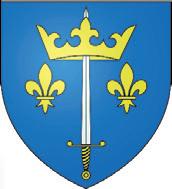
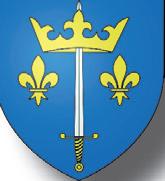

A leading advocate for people with disabilities has urged the establishment of a foundation to help desperate families struggling to have their children with special needs accepted in Catholic schools - and schools desperate for funds to help pay for staff to work in this field
BY ANTHONY BARICHDISABILITIES advocate Barbara Harris has proposed the establishment of a foundation to relieve parents of the stress of finding funds to help educate their special-needs children in Catholic schools.
The proposition was made as students with disabilities have been turned away from Catholic schools due to lack of funding, while other parents think twice about telling the school their child has a disability due to what happened to their friends in similar situations, Mrs Harris said.
Equally concerning is the number of parents for whom the constant stress and anxiety about ongoing funding and support once the child is accepted and enrolled in the Catholic system, results in feeling forced to withdraw their children from the Catholic school, she said.
“This action is a significant issue for the family, for whom a Catholic education was so important to the faith development of their child, the Please turn to Page 2



PERTH pilgrims trekking the Camino Salvado trail suspect they may have stumbled upon the actual trail that colonial-era Bishop Rosendo Salvado trod in the mid1800s.
Bishop Salvado – Benedictine monk, missionary, musician and author – walked from New Norcia – Australia’s only monastic town that he built – to Perth to perform piano concerts to raise money for his outback mission.

Pilgrims have been walking the Camino Salvado since 2009, organised by Subiaco parishioner Dr Duncan Jefferson who was inspired by his own experience trekking the Camino de Santiago – The Way of St James – in Spain with his wife.
The previous route used by the Perth pilgrims detoured around Please turn to Page 5
Irene Villa is a bed and breakfast to rest and renew - with a difference.
Run especially for Western Australians living in regional and rural areas and for carers who feel the need for some respite, it is also a ministry of the Sisters of St Joseph of the Sacred Heart in South Perth.
The Villa is situated at 13 Alexandra Street, South Perth, in the leafy grounds of St Joseph’s Convent – just one block away from the beautiful Swan River and the shops of Angelo and Mends Streets.
The mission of Irene Villa is to “relieve suffering and bring hope” by providing low-cost accommoda-
tion. Apart from providing temporary accomodation for carers and others needing short respite and those from rural areas who need to visit family members in city hospitals, it is also available to those from the country who need to stay somewhere while they have medical tests or outpatient treatment in a city hospital.
Irene Villa meets several needs. It is available as a place of quiet for private or small group retreats and also operates as a city base for missionary priests who live in remote country parishes.
The accommodation includes eight single rooms and two double rooms with single bunk on top, each with an air-conditioner; three
shared bathrooms; a large kitchen/dining room; two lounge/TV rooms; a laundry, and four private outdoor sitting areas.
A Continental breakfast is available in the kitchen each morning and guests are welcome to prepare other meals in the kitchen.
Shops such as supermarkets are just a short walk away in Angelo Street, or a little further in Mends Street.
The property is smoke-free, a communal phone is available with an honour jar, parking is available opposite, a bus and ferry to the city operate nearby and Mass is celebrated in the Convent chapel next door or at St Columba’s Church across the road. The cost is $35 per
person, $50 per couple per night for bed and breakfast.
Irene Villa was named after Sister Irene McCormack, a Sister of St Joseph of the Sacred Heart, who was murdered by rebels in Peru in May 1991.
Irene was originally from the farming community of Trayning, WA and was one of seven children. On completing her secondary education, she entered the Sisters of St Please turn to Page 4
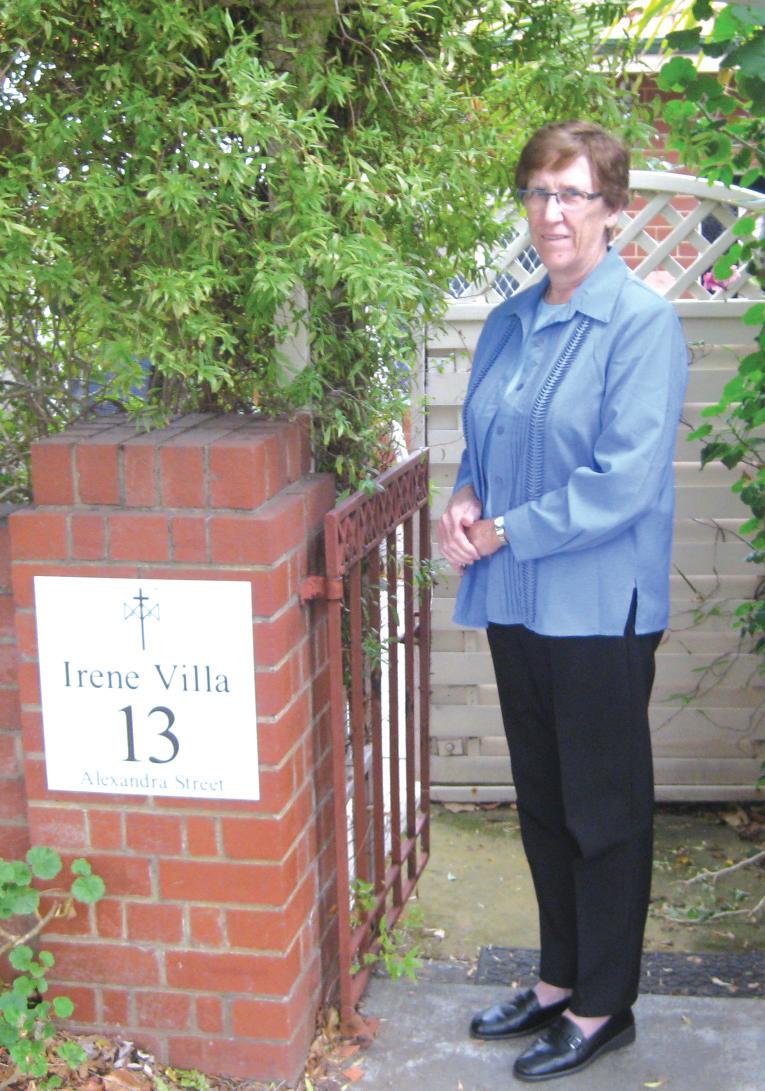
PETER KENNEDY and CHRIS OLNEY on the highlights of splashing around in the Dead Sea, and a special pilgrimage to the Middle East that was slightly derailed. Page 9

A leading advocate for people with disabilities has urged the establishment of a foundation to help desperate families struggling to have their children with special needs accepted in Catholic schools - and schools desperate for funds to help pay for staff to work in this field
By Anthony BArichDISABILITIES advocate Barbara Harris has proposed the establishment of a foundation to relieve parents of the stress of finding funds to help educate their special-needs children in Catholic schools.
The proposition was made as students with disabilities have been turned away from Catholic schools due to lack of funding, while other parents think twice about telling the school their child has a disability due to what happened to their friends in similar situations, Mrs Harris said.
Equally concerning is the number of parents for whom the constant stress and anxiety about ongoing funding and support once the child is accepted and enrolled in the Catholic system, results in feeling forced to withdraw their children from the Catholic school, she said.
“This action is a significant issue for the family, for whom a Catholic education was so important to the faith development of their child, the Please turn to Page 2


PERTH pilgrims trekking the Camino Salvado trail suspect they may have stumbled upon the actual trail that colonial-era Bishop Rosendo Salvado trod in the mid1800s.
Bishop Salvado – Benedictine monk, missionary, musician and author – walked from New Norcia – Australia’s only monastic town that he built – to Perth to perform piano concerts to raise money for his outback mission.
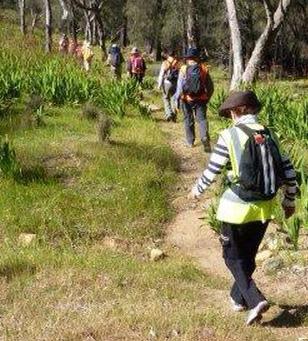
Pilgrims have been walking the Camino Salvado since 2009, organised by Subiaco parishioner Dr Duncan Jefferson who was inspired by his own experience trekking the Camino de Santiago – The Way of St James – in Spain with his wife.
The previous route used by the Perth pilgrims detoured around Please turn to Page 5
Irene Villa is a bed and breakfast to rest and renew - with a difference.
Run especially for Western Australians living in regional and rural areas and for carers who feel the need for some respite, it is also a ministry of the Sisters of St Joseph of the Sacred Heart in South Perth.
The Villa is situated at 13 Alexandra Street, South Perth, in the leafy grounds of St Joseph’s Convent – just one block away from the beautiful Swan River and the shops of Angelo and Mends Streets.
The mission of Irene Villa is to “relieve suffering and bring hope” by providing low-cost accommoda-
tion. Apart from providing temporary accomodation for carers and others needing short respite and those from rural areas who need to visit family members in city hospitals, it is also available to those from the country who need to stay somewhere while they have medical tests or outpatient treatment in a city hospital.
Irene Villa meets several needs. It is available as a place of quiet for private or small group retreats and also operates as a city base for missionary priests who live in remote country parishes.
The accommodation includes eight single rooms and two double rooms with single bunk on top, each with an air-conditioner; three
shared bathrooms; a large kitchen/dining room; two lounge/TV rooms; a laundry, and four private outdoor sitting areas.
A Continental breakfast is available in the kitchen each morning and guests are welcome to prepare other meals in the kitchen.
Shops such as supermarkets are just a short walk away in Angelo Street, or a little further in Mends Street.
The property is smoke-free, a communal phone is available with an honour jar, parking is available opposite, a bus and ferry to the city operate nearby and Mass is celebrated in the Convent chapel next door or at St Columba’s Church across the road. The cost is $35 per
person, $50 per couple per night for bed and breakfast.
Irene Villa was named after Sister Irene McCormack, a Sister of St Joseph of the Sacred Heart, who was murdered by rebels in Peru in May 1991.
Irene was originally from the farming community of Trayning, WA and was one of seven children. On completing her secondary education, she entered the Sisters of St Please turn to Page 4

Saints

CATHOLIC Mission’s 2010 Annual Report released last week shows total revenue for 2010 reached $18.28 million, an increase of $5.33 million from 2009 figures.
The amount of $18.28 million is a record for Catholic Mission’s fundraising and income from other sources in Australia. The people of Bunbury contributed almost $109,000 to Catholic Mission in 2010. In addition the schools raised almost $9,500, more than double 2009 figures.



“We thank the people of Bunbury for their loyal commitment to our cause of bringing the good news of Jesus to ever more of the world’s people through supporting our missionaries, seminarians and catechists, the subsidising the building of parish infrastructure,” Perth’s Diocesan Catholic Mission Director Francis
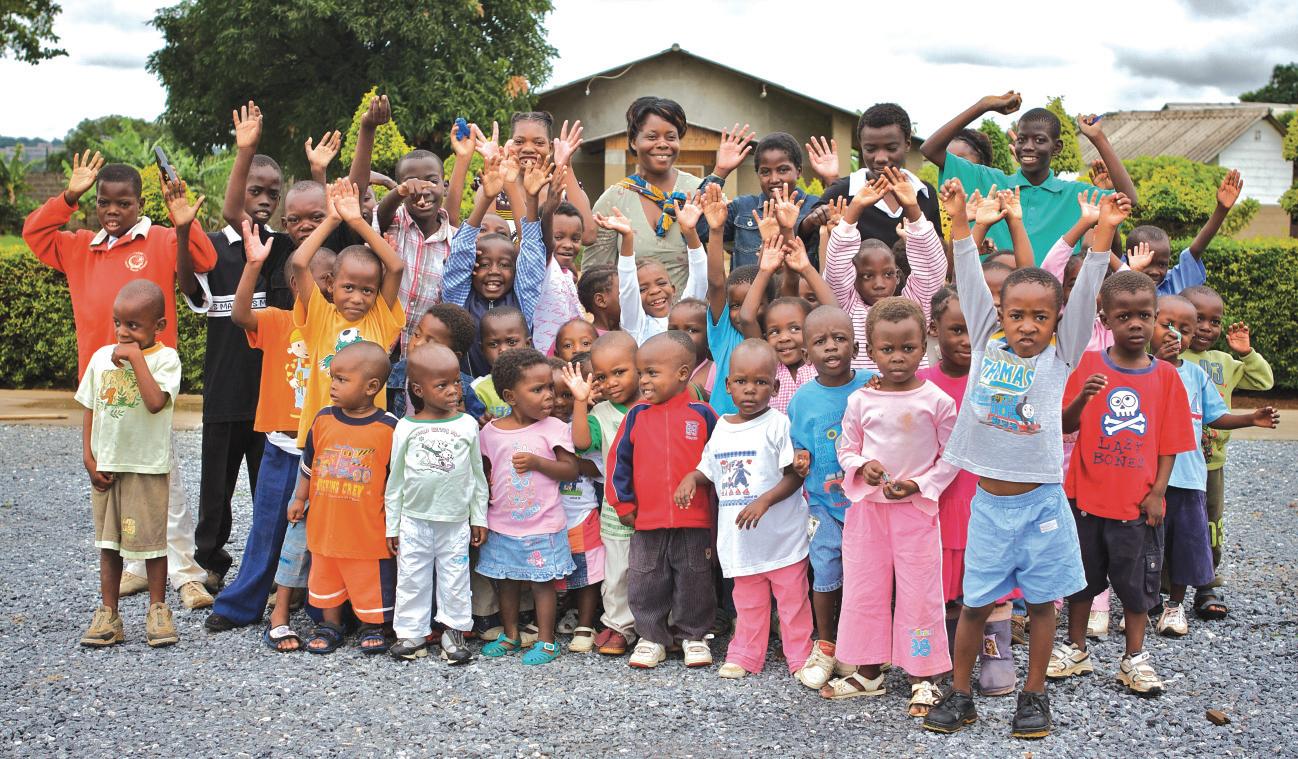
Leong said. Catholic Mission is part of the global network of the Pontifical Mission Societies formed 189 years ago in France and now operates in 160 countries. Australia’s contribution supports missionary works in 131 dioceses in 37 countries, including Australia.
In 2010 Catholic Mission in
Australia assisted more than two million Catholics in their spiritual growth and outreach to others.
Catholic Mission’s annual report reveals the funding of:
● 507,414 children in their spiritual and practical needs
● 9,203 catechists and 3,983 seminarians in training
● The building, upkeep and maintenance of 79 churches, presbyteries and pastoral centres and 15 religious convents
● Subsidies for 17 Catholic radio and TV broadcasters.
The report also reveals projects that Catholic Mission funds in Thailand, Pakistan, Timor-Leste, Australia, the Solomons, Haiti and Bolivia, Ethiopia, Zambia and Zimbabwe.
It also reveals extensive resources given to schools, including the Village Space drama troupe – dramatised, interactive stories of social justice carried out in schools across Australia - and opportunities for Australians to experience cross-cultural immersion and mission exposure.
Downloadable copies of Catholic Mission’s 2010 Annual Report are available at www.catholicmission.org.au or by contacting CM on 1800 257 296.
Continued from Page 1 siblings and the family unit,” Mrs Harris said.
“The stress is causing many families to feel unvalued by the Church, some to feel rejected by their church some to disintegrate as a family unit, and to leave the Church in anger or/ and disappointment.”
Editor
Journalists



Peter Rosengren office@therecord.com.au
Bridget Spinks baspinks@therecord.com.au
Mark Reidy mreidy@therecord.com.au
Anthony Barich
Mrs Harris is coordinator of the Emmanuel Centre, a self-help centre run by and for people with disabilities. She also helps families deal with red tape and helps facilitate their inclusion into their local Catholic community.
WA-based National Catholic Education Commission chair Therese Temby told The Record that she doubts parents have been refused enrolment because it is illegal under the discrimination Act.
Mrs Harris and Ms Temby agreed that schools have difficulty finding the resources to meet the needs of students with disabilities. Mrs Harris said it should not be the schools’ sole responsibility. “My issue is not with Catholic Education. If we as Church say abortion is wrong, we as Church have a responsibility to human beings, as that’s what we’re talking about,” Mrs Harris said.
Ron Dullard, director of Catholic Education in WA, told The Record that “we could always do with more money (for students with disabilities) and we don’t get as much as the State schools do, but no child can be denied access to any Catholic school because of disability”. He said it comes down to the school, the local CEO and parents coming to an agreement of what the child’s needs are, but admitted that these can conflict.
“Some parents would want a fulltime aid, and we may say that a fulltime aid might not be in the child’s best interest. So it’s about expectations and what we can provdide. Our numbers of students with disabilities continue to grow and that’s a good thing,” he said.

advisors that work with schools and parents to find the right arrangement.
Both Mr Dullard and Ms Temby told The Record they would prefer that the government fully fund every child to be educated - regardless of what school they go to, in accordance with their level of disability - over Mrs Harris’ proposition.
Ms Temby called the 10 May Federal Budget’s announcement of $200 million over four years for additional resources for students who have a disability a “breakthrough, because we’ve been asking for increased funding for students with disabilities for years”. Some parents will also benefit from changes to the family tax benefit for their children who complete school, while an extension to the education rebate will help some families with the cost of school uniforms.
She also welcomed the Federal Government’s 30 May pledge that no school will lose a dollar as a result of the Gonski Review of Funding for Schooling, which is expected to hand down its findings by year’s end.
Harris said. “If someone started a fund, there must be lots of other people who would like to contribute to such a fund, but we don’t even talk about it or pursue it as a commitment of the Archdiocese.
“Out of that, the Holy Spirit will work and imbue people with creative ideas regardless of whether the government increases their funding, because the community has to say ‘this is our responsibility, in the name of the truth that we hold and the faith we express’.
“Catholics should not have to bear the brunt of finding a place for their child in the Catholic community. We as a Church have to say this is too important to allow it to go on.”
There is also the agonising stress of months of negotiations that often entails acquiring funding for such students in Catholic schools, which is negotiated by the school and the local Catholic Education Office.
cent of each week with Luke, but they’re not sure whether they will have to go through this again for next semester.
“The frustration is that I am a practising Catholic and I don’t believe I should have to fight for this; and now we’ve got to a stage we’re happy with, we might have to start the process again later in the year,” Mr Gomez, 46, a sales manager for a communications company, said. “My main gripe is that if we took him out and into the government school next door we’d probably have a full time aid for him there, based on conversation with friends of ours (who have children in that system). Funding there is better and easier (to obtain).
“We still don’t know if it’s term by term or year by year. Either way I don’t think it’s good enough, as it’s taken us half the year that Luke is unsettled for. It’s not like we have a tree out the back and money falls off it. We only want what’s best for Luke. I don’t want to pull him out, but if it’s a last resort I would and put him into a (government) school with full funding.”



There are 25,000 students with a disability in Australian Catholic schools out of 703,000 in the Catholic education system. Catholic Education WA has 13 “highly regarded and qualified” special education
However, Mrs Harris said Catholic parents should not have to rely on the government for their children to be educated.
“It’s about getting together and being creative on how we can achieve assistance for parents of children with disabilities to be educated,” Mrs
Such is the case for Ellenbrook couple Andrew and Cheryl Gomez, a single-income couple who have been fighting for five months to get funding for a personal aid for their son Luke, 5 (Down Syndrome), in Year 1 at St Helena’s Catholic Primary School.
Though Cheryl has taught Luke to read at home, he is behind his peers and needs a one-on-one personal aid to guide him through classes.
The couple has now agreed to an aid spending about 70 per
However, he prefers to have Luke, the third of four boys, to attend St Helena’s which he intends all his four sons to attend. Mr Gomez told The Record he would back Mrs Harris’ proposal for a fund established in the Archdiocese available to parents who want to enroll their children in Catholic schools.
Luke Gomez, 5, with his brother Aidan, 7, are pictured at a fun park. PHOTO: COURTESY OF ANDREW GOMEZ BY ANTHONY BARICH
BY ANTHONY BARICH
THE Fulton J Sheen Society raised about $6,000 gross by its annual concert at Trinity College on 25 May for overseas missions and the continuation of works inspired by the late prelate.
The concert, which has been hosted at Trinity College since 2000, has raised over $50,000 for missions in India, Kenya and China and for a Fulton J Sheen Scholarship established in 2006 at the Seminary of the Good Shepherd in Sydney. It has also funded a series of television spots on Channel 9 by Archbishop Barry Hickey.
Funds from the concert will also assist Linda’s House of Hope, which helps women escape prostitution and start new lives.
The funds will go towards the Branches Project established by Perth Catholic Joanna Lawson, who works with the Untouchables in India, a class of people on the fringes of Hindu society.
Funds will also assist Kikumini Catholic Mission in Kenya, following a request by Perth Vicar for Migrants and Guildford parish priest Fr Blasco Fonseca, who worked in Kenya for 30 years.
Headlining the concert this year was local Baritone and Trinity College graduate Daniel Mullaney, who was taught by Martin Tobin, who co-founded the Fulton J Sheen Society with his father Daniel in 1999.
Daniel, 20, has been a member of the St Mary’s Cathedral choir since he was 11 and now plays a prominent role as its Principal Cantor – a position he has held since he was 17.
Daniel, who has sung at previous An Hour For Sheen concerts, recently performed a series of concerts at the Cathedral to raise money to help pay off the remaining $2.4 million of the total of $32.9 million.
He is currently studying performance at the WA Academy of Performing Arts.
He was accompanied by Wembley Uniting Church organist and choir director John Meyer, who also performed solo performances of Chopin and Grieg.
Mr Meyer also accompanied Soprano Yann Kee, who returns after a successful performance last year. The Malaysian-Born Yann Kee, who majored in Vocal Performance at the University of WA, has won many awards at the North Perth Music Festival and competitions with the WA Music Teachers Association.
ARCHBISHOP
Barry Hickeywill headline a major University of Notre Dame Australia event that seeks to encourage an intellectual engagement with the Catholic faith on 7 June.
The Archbishop will speak on Church and the Modern World at midday in the Michael Keating Room on Cliff Street in Fremantle as the second event in the Bishops Speaking Out series that Cardinal George Pell launched in Sydney on 29 March.


Yann Kee, who has also performed with the Australian Opera Studio in productions of The Marriage of Figaro, Tancredi and Die Fledermaus, teaches singing at Perth College and Corpus Christi College.
Also headlining the night was the renamed singing group Voyces, previously known as the St Joseph’s Chamber Choir which sprang out of the Subiaco parish.
Inspired by the musical direction of Trinity College Director of Music Dr Robert Braham, Voyces takes a musical and academic interest in modern choral repertoire, with current arrangements of Renaissance masters, vocal settings of Tango Nuevo and renditions of contemporary works.
South-African born Rhodes Scholar and former professional actor on screen, stage and radio in Australia, Roland Payver, was a lastminute call-up to replace poet June Glen who was unable to attend.
The concert climaxed with Daniel and Yann Kee performing a rendition of Francesco Sartori’s Time to Say Good Bye (Con te partirò), made famous in recent times by blind tenor Andrea Bocelli.
Archbishop Hickey’s two-hour address will discuss the roles of the clergy and lay people in representing the Church in the modern world.
The Bishops Speaking Out series is an initiative of the university’s Centre for Faith, Ethics and Society (CFES) which aims to develop “ethical intelligence”

confirmed by faith to promote action which serves justice, charity and the common good.
The discussions in the Bishops Speaking Out series aim to give the audience a deeper understanding of the Church’s involvement in issues relevant to education, health, social justice, religious commitment and community life.
Parramatta Bishop Anthony Fisher OP will continue the series in November at UNDA’s Sydney campus, while CanberraGoulburn Archbishop Mark Coleridge and Darwin Bishop Eugene Hurley will speak as part of the Bishops Speaking Out series next year.
The series is part of the mission of a Catholic university like Notre Dame to “keep alive the learning that allows reason to flourish and prosper and not wither up into dry rationalism - which is able to study the amoeba in acute detail and recognise and explain the reality of love”, Cardinal Pell said at the 29 March launch.
In explaining the contribution that Christianity has made to intellectual life, Cardinal Pell
challenged the view that “the faith that modern reason critiqued was irrational”.
He argued that the idea “Christianity induced the socalled Dark Ages” is undermined by the contribution which Christian monasteries made to the preservation of learning.
“Far from burning books and destroying the learning of Ancient Rome, Christian monasteries hoarded books in their libraries and set monks to work throughout Europe copying the Latin texts of learned pagan writers such as Virgil, Ovid, Cicero, Pliny and Horace and ensuring their preservation,” the Cardinal said.
In addition to his lecture that day, Cardinal Pell also launched Solidarity: The Journal for Catholic Social Thought and Secular Ethics, a bi-annual publication that is a joint project between CFES, UNDA and the Office of Justice and Peace of the Sydney Archdiocese. The publication promotes ethical reflection on a range of topics and issues of practical importance and theological and secular significance.



THE experiences of disadvantaged people are the key to building a truly inclusive Australian society, not forcing people to rely on charity, St Vincent de Paul Society national council chief executive Dr John Falzon said.
In days gone by many now socalled “potential workers” were seen as “expendable and surplus to the needs of capital,” he said, but in the Federal Budget released last month the push to “get potential workers into the labour market is intoned as a matter of national emergency”.
The greatest power for progressive social change lies precisely with the excluded, Dr Falzon said, because people who can best define and interpret the reality of exclusion and socio-economic insecurity are also potentially ideal to determine the means towards social inclusion.
Addressing the SVDP Society’s 25 May Winter Appeal Launch at the Perth Town Hall, he condemned the Gillard Government and the Federal Opposition as “cheerleaders for paternalism”, because entire locations that were previously described as “surplus populations” are now described as “the unwilling workers that the nation is crying out for”.
He said these people are being penalised and humiliated by “tiresome moralising” that tells them to “take responsibility for a chance”.
“The government and business community are doing all they can, so the narrative goes, to help you. ‘Now you’ve got an obligation to help yourself and stop being dependent on the State,’” he said.
“This discourse is as inaccurate as it is offensive”, and ignores the reality while wallowing in the “shameful rhetoric of welfare bashing”, Dr Falzon said in his talk,
WESTERN AUSTRALIAN ACADEMY OF PERFORMING ARTS presents...


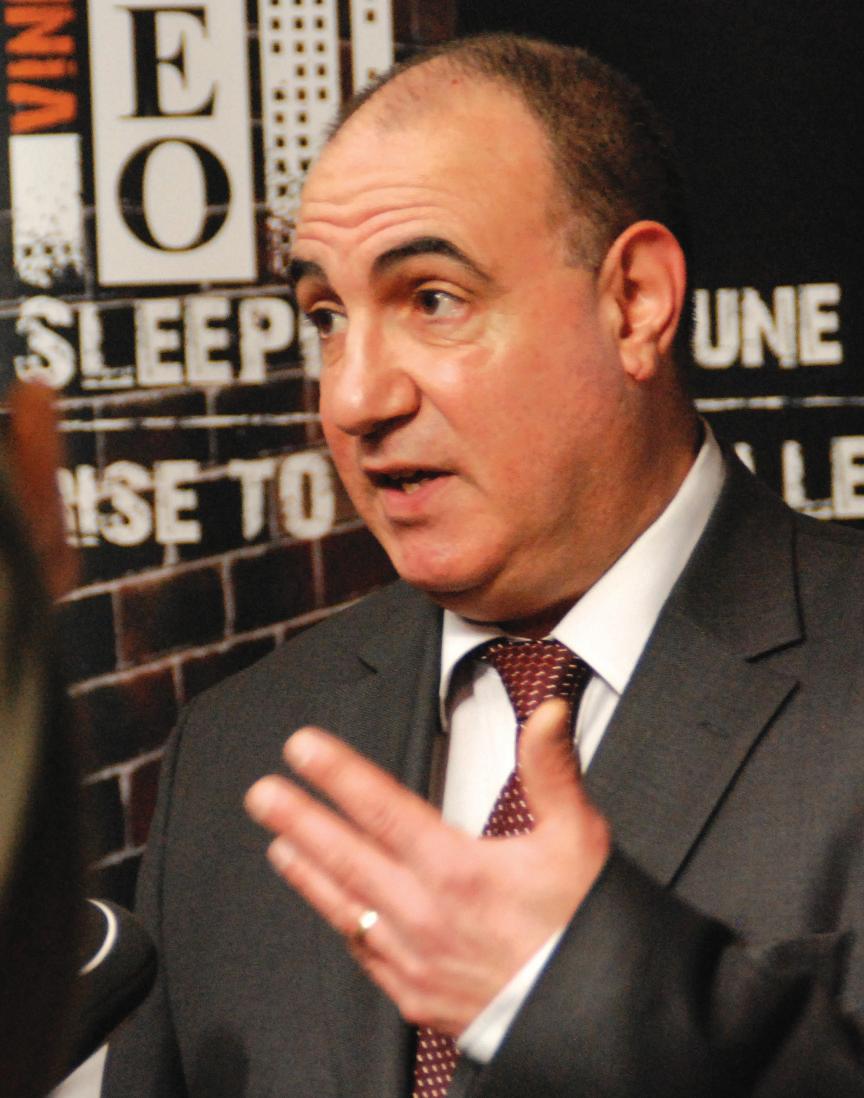

Suspending a young mother’s entire income, for example, only causes hardship for mother and child, forcing her to get help from family, friends, neighbours or a charity, he said.


titled The Forgotten People. This mentality also defies the Australian Bishops’ conference’s 1996 Social Justice Statement that stated: “In the main, people are poor not because they are lazy or lacking in ability or because they are unlucky. They are poor because of the way society, including its economic system, is organised.” Reflecting on this, Dr Falzon called on a strong, flexible social security system that “actually delivers social security rather than insecurity and vilification,” which although essential to building a fairer Australia, is not the ultimate answer.
The social security system should merely be a means to social, economic and political inclusion rather than an end in itself, he said.
“The government can threaten with all the sticks under the sun but this will not lead people to learning,” Dr Falzon said.
“It will teach her that she is of little value (to society) and that she is able to be controlled and disciplined and made to ask for charity,” Dr Falzon said. He cited the 1993 research paper Much Obliged - by the St Vincent de Paul Society’s Gavin Dufty, Stephen Ziguras from the Brotherhood of St Laurence and the University of Melbourne’s Mark Considine – which revealed that increasing compliance measures under the banner of mutual obligation did little to facilitate employment participation. “Contrary to the aims of active labour market policy, the emphasis on compulsory activities appears to generate avoidance
and resentment. While people may comply, these requirements are in practice not a means to finding work, but rather a necessity for remaining eligible for benefits. In effect, then, the system operates for many disadvantaged job seekers not as ‘welfare to work’ but ‘welfare as work’,” the report said.
Dr Falzon added that since 1996 the unemployment benefit has fallen from 54 per cent to 45 per cent of the after-tax minimum wage.
“We build massive walls around people on the basis of their race, class, gender or disability. The same people are then condemned for lacking the ‘aspiration to scale these walls,” he said. He praised the Federal Budget’s investment in mental health as “ground breaking”, but expressed hope that the punitive treatment of people on social security benefits do not cause greater problems with mental health.
A riotously entertaining musical comedy with music & lyrics by
George and Ira GershwinDirected By Crispin Taylor
Performed By WAAPA Music Theatre REGAL THEATRE
10 - 18 JUNE

1300 795 012 ticketek.com.au waapa.ecu.edu.au
Continued from Page 1




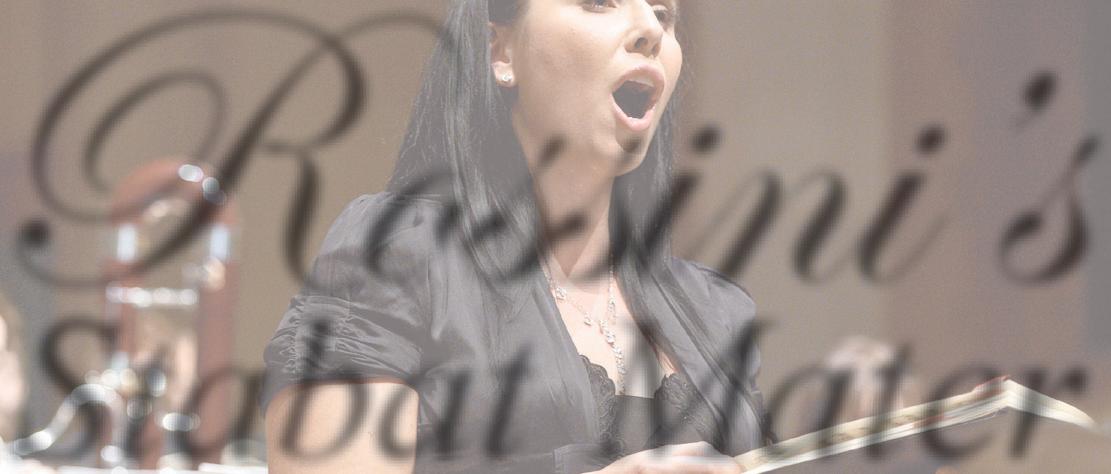


Joseph in 1956. In 1987, Irene answered the call to minister to the Peruvian people of Huasahuasi. She has been nominated for sainthood by the Catholic Church of Australia.
Josephite Provincial Leader Sr Pauline Morgan rsj gave The Record these examples of some people who have stayed at Irene Villa: Pat came to Irene Villa for an appointment with her MS specialist and planned to return home the next day.
However, her condition worsened and she was told to stay in Perth for further appointments. Without any fuss, Pat was able to stay at Irene Villa for the extra nights. While she waited for her extra appointments, Pat was able to pray in the Convent chapel, enjoy a quiet walk along the river and experience the unspoken support and companionship of others who were staying at Irene Villa.
June was overwhelmed by the bad news she got at the hospital. She contemplated ending her life. On entering Irene Villa and meeting Sr Chris, June felt a deep peace

come over her. As June told her story over a coffee, Sr Chris quietly listened and later gently suggested a counsellor and gave June a phone number. The counsellor was able to connect June to the resources that were available to her and help her take one step at a time.
Betty from a country parish discovered that Teresa was not keeping her specialist appointments as she felt she couldn’t manage travel to Perth. Betty booked Teresa and herself into Irene Villa, took her to the appointments and generally looked after her while she was in Perth.
Ted and Mary live about 400km from Perth. Mary was seriously ill in a Perth hospital.
Their adult daughter lives interstate and her baby was very sick at the time. Ted was very distraught and couldn’t seem to make any decisions or manage the simplest things in his life.
Their daughter rang their parish priest who contacted Irene Villa – that was all that was needed. After a few days at Irene Villa, Ted regained his confidence and was able to visit his wife every day in hospital. Ted and Mary now both stay at Irene Villa for a week every
six months while Mary has followup care. Every six months, a group of grandmothers who are the primary carers for their grandchildren, have a respite weekend. They are now good friends, have exchanged phone numbers and are on call to support each other in emergencies.
They look forward to their weekends at Irene Villa where they find friendship, support, peace and understanding.
People can share in this work that would be so dear to St Mary MacKillop, who said: “Never see a need without trying to do something about it.”
Volunteers can be on a roster to welcome guests and perhaps have a “cuppa” with them; assist with keeping Irene Villa an attractive, clean and restful place for the guests; from time-to-time bring around a pot of soup for guests who do not feel up to cooking for themselves; help maintain the garden and the general outside environs; make a donation towards running costs and general maintenance.



A discernment weekend for single men, 19-40 years.
This weekend is offered regularly and begins on a Friday night and includes prayer, meditation, reflec- tion and self discovery. It is designed to help discern life: Married, Single, Religious, Priest...
To make a booking or chat further please call
AUSTRALIAN Catholic Migrant and Refugee Office director Fr Maurizio Pettena CS has challenged the Australian Government to consider the dignity of human life when dealing with issues of irregular migration. Reflecting on the phenomenon of Global Migration, Fr Pettena
questioned Prime Minister Gillard’s 7 May deal to relocate up to 800 new boat arrivals to Malaysia in return for Australia’s acceptance of 4,000 people with granted refugee status. Fr Pettena challenged the government to increase its humanitarian intake.
“It remains essential for
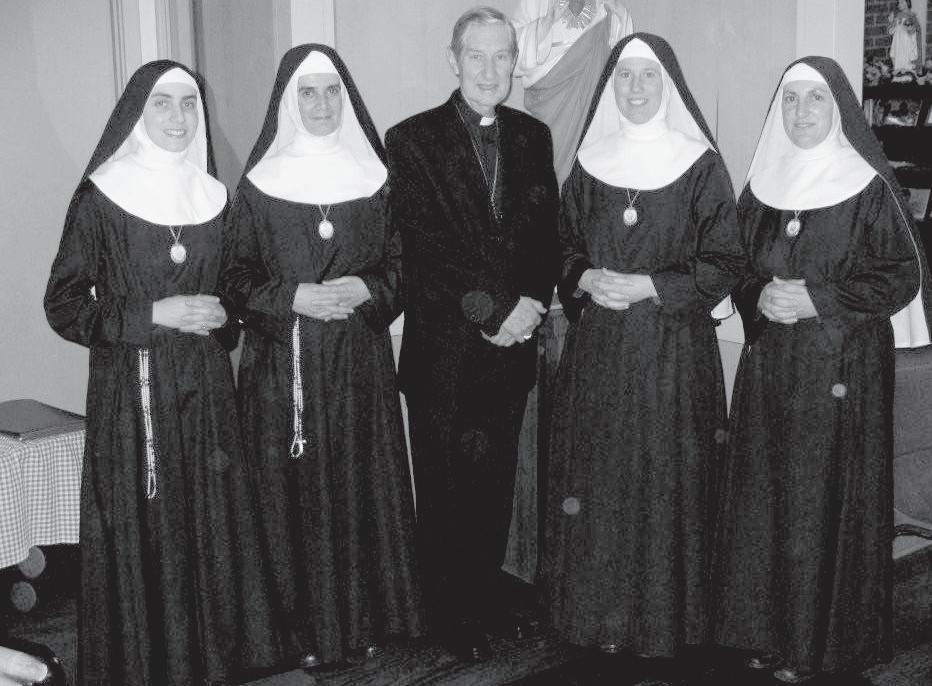
THE Chain of Mary Association Committee held an Olde English High Tea Afternoon at the Good Shepherd Parish Centre in Lockridge on 14 May to raise money for a Religious congregation that lives on providence and provides respite care for families in need.
The service provides an early childhood setting similar to that of Family Day Care, where children can be cared for in a safe, secure and developmentally appropriate environment.
The home operates through certain agencies that deal with families who require support. This is the apostolic work of the New Apostolate Consecrated in the Heart of the Holy Family, a community of sisters in the Archdiocese of Perth. The service operates Monday to Friday.
This is a non-profit service for parents and/or children (0-6 years) who are distressed with the demands of daily living and need respite. Those eligible for the service through referrals include parents struggling financially, mothers experiencing post-natal depression or families where child welfare is an
issue. A contribution to cover the cost of the child’s food for the day is all that is requested.
The High Tea included raffles and entertainment from singer Amanda Canzurlo and Ian Cristie from Avalon Duo, who donated their time on the day to raise money for the home.
THE foundation members belonging to the community of Sisters of the New Apostolate Consecrated in the Heart of the Holy Family made their perpetual profession at St Mary’s Church in Leederville in 2009. They live on providence and have been looking for a new house. Until now they have lived in temporary accommodation in the Shire of Swan paying $430 a week.
Home of Mary Consoler is registered as a Deductable Gift Recipient and is a not-for-profit service; any donations over $2 are tax deductable and can be made to Mary Consoler of those Abandoned and Orphaned Fund
If you know of anyone who may be in need of this service, or can help the Sisters acquire a three to four acre property, contact 0420 526 206 or 0437 700 247.
The Archbishop Goody Award was originally established in 1983 by The Most Reverend Sir Launcelot Goody, KBE. The Award aims to further the lay apostolate in the Archdiocese of Perth by financing the formation, education and training of lay people to serve the Church in Perth according to their particular calling and talents.
Applications for the Archbishop Goody Award are currently being invited to be submitted before the 31 July 2011. Ordinarily Awards are up to $5000. Please contact Kim at St Thomas, Claremont, on 9384 0598 or email claremont@perthcatholic.org. au for an application form or for any further information.
Australia to hear asylum seekers when they knock at our door. Concern for the welfare of asylum seekers must not stop at our border”, he said.
“We acknowledge that the policy of sending the next 800 boat arrivals to Malaysia might appear a deterrent for further boat arriv-
Coninued from Page 1 sections where it was thought there were no trails, but Dr Jefferson discovered a long-forgotten, uncharted road through Julimar State Forest which travels “precisely where we want to go”.
In a development that aligns it closer to its progenitor in Spain, more landholder farmers are allowing the pilgrims to cross their land, allowing a clear path away from Great Northern Highway all the way to New Norcia.
Similarly, over the course of centuries, small communities sprang up along the Camino de Santiago route to provide the pilgrims with shelter and food.
Karen Derwent, committee member of the independent, ecumenical, non-profit organising group Camino Salvado, said they know they are close to Salvado’s trail as it is known the Bishop went through the Chittering Valley.
“Colonial authorities gave them (Salvado and his company) easements for them to stop for the night – including huts and wells –including one in Chittering valley in the corner between two hills and a road just across from the river,” Karen said.
Here can be seen remains of a hut and even a horse’s trough.
“We have no proof yet that this is Salvado’s trail, but we believe we have stumbled across his original path and we are investigating further. Some of the older local residents said these easements are where the monks used to camp.”
Today’s Trail
The Department of Conservation
als, however we cannot condone this policy, as essentially ‘swapping human life’ goes against the moral teaching of the Church.”
“While Malaysia appears willing to uphold the key aspect of the Refugee Convention to not return asylum seekers to the origin of danger; this alone does
not afford asylum seekers the opportunity of a sustainable life”, he said.
“The burden of irregular migration flows is one which needs to be shared more equally between countries, based on their capacity to care for asylum seekers”, he said.

and Land Management told Camino organisers that there was no path through the forest, “but we found one” which takes pilgrims straight through to Old Plains Road, which is part of the wildflower trail, a renowned tourist attraction for six months of the year.
“We’re not sure whether the monks used it, but it’s very quiet. We were there two days and we saw two cars. It’s more conducive to prayers and chatting,” Karen said.
LotteryWest has given organisers a $14,000 grant to employ a Trails Consultant to produce a Draft Strategy for the Trail. The Camino committee is now applying for more funding from Lotterywest, the private and government sectors, to carry the Strategy forward.
The funds will be used to build trail structures including picnic tables, water tanks and eventually accommodation, a lack of which is currently limiting the Camino to 30 each time.
The trail starts at St Joseph’s Catholic Church in Subiaco, where pilgrims are given a blessing and a hand-painted scallop shell, symbolic of pilgrimage as Santiago pilgrims often arrived by boat to start the trek.
It is also redolent of the Shell of
St James, a scallop shell often found on the shores in Spain’s northwest. The Camino trail follows the Swan River up to Walyunga National Park, through the Chittering Valley to Bindoon.
It is believed the pioneering monks would have continued along the Avon River towards Toodyay then up via what is now Old Plains Road to follow the accessible watering holes. But this would take current walkers an extra day, and at this stage accommodation is hard to source in those sparsely populated areas.
The city section of the pilgrimage includes St Mary’s Cathedral on the way to Guildford.
Their 2009 pilgrimage was filmed by the ABC and turned into an episode on Compass, while last year 30 pilgrims each undertook two pilgrimages. There will again be two this year, from Sunday to Sunday starting on 21 August and 4 September for the 140km, sevenday hike.
The pilgrimage costs $800 for eight days and seven nights, which includes all meals, accommodation and transport. Walkers carry a small day pack and water; baggage is transferred direct to the accommodation.
 The Camino Trail as marked out on Google Maps.
The Camino Trail as marked out on Google Maps.
Parish builds a fun youth group as part of “prevention strategy” where friendships are built on faith, valuesBY BRIDGET SPINKS
LESMURDIE parish priest Fr Ken Asaba celebrated the parish’s first youth Rock Mass at Our Lady of Lourdes on 29 May.
The rock music for the Mass featured hymns such as Come now is the time to worship and In You I Stand which were chosen to put parishioners in the frame of mind for prayer, Fr Ken said.
The First Reading, taken from the Catholic Youth Bible and written in simpler language, replaced the usual Sunday first and second readings, while the Penitential Rite was replaced with a simpler prayer.
After the Mass, 31 young people aged 13 to 17 attended the parish’s second youth group gathering, which included a shared meal - hot dogs - and several fast-action games in the parish hall from 6.30pm to 8pm. The first youth group gathering on 10 April drew just as many teenagers and there were three apologies for Sunday’s gathering from more who wanted to come but could not make it.
A crew of six supporting adults and five young adults aged 18 and up run the youth group and a week beforehand they meet with Fr Ken to discuss the programme of games.
“We want it to be well organised; it’s very important for them. The games happen quickly to keep them interested,” Fr Ken said.
Mitch Sala-Tanna, a Lesmurdie parishioner and a supporting parent, said that this was the parish’s second attempt at getting a youth group up and running.
After Christmas, the parish distributed a questionnaire asking the youth what would interest them. Up to 20 teenagers responded.

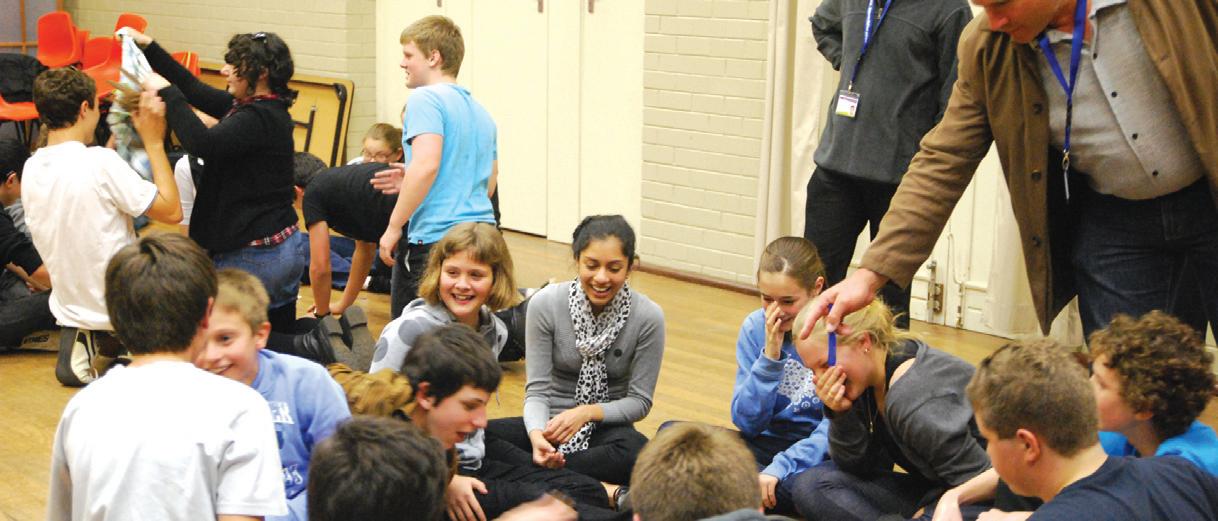
Fr Ken said that some wanted camps and retreats; but while they were not interested in preaching they would be happy with testimonies. So when Fr Ken gives a little reflection, he said, he gives it more as a piece of advice.
Fr Ken has drawn up a prayer card especially for the youth group with the guiding motto from Micah 6:8 “The Lord has told us what is good. What he requires of us is this: to do what is just, to show constant love, and to live in humble fellowship with our God,” which he hopes is easily memorised and a motto that will stay with them long after youth group is over.
Lesmurdie parishioner Gina Price is a mother of two teenage daughters who both come to youth group and one of the parent support crew who got the initiative off the ground. She said she was motivated to help run the youth group because she wants the parish youth to experience clean fun, to show them that they don’t have to be drunk or dangerous to enjoy themselves. Aware of the secular
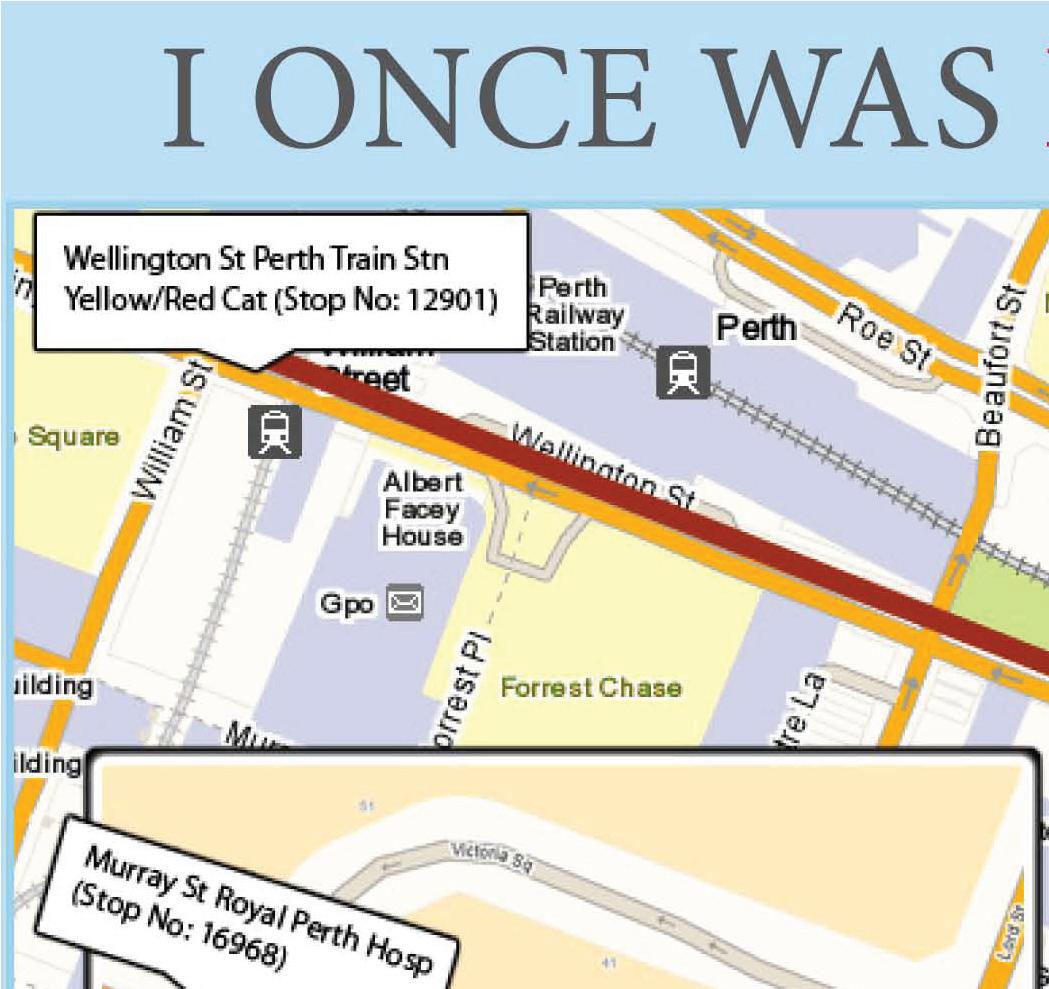
youth culture prevalent today, she said the youth group was also a prevention strategy.
“We want to get them when we can still knead them,” she said, referring to the early high school 13-17 year old age bracket the activities are pitched at.
Several 13 and 14-year-old girls who go to St Brigid’s Lesmurdie and Lesmurdie Senior High School are part of the youth group. They said they came back a second time, because the first one was fun. Fr Ken said that because they are still in the early stages, the games and the group is are focused on helping them reveal who they are in a fun way and to help them form friendships with like-minded people who share the same values.
He said the youth group is purposefully held after Mass so that the young ones will be nourished on the Word of God and the Eucharist first, and then have fun socialising afterwards.
For more details, email lesmurdieyouthgroup@hotmail.com or call Gina Price on 0409 359 331.

THE new Treacey Hall at Iona Presentation Primary School in Mosman Park was officially opened and blessed by Corpus Christi Mosman Park and Our Lady Star of the Sea Cottesloe parish priest, Fr Freddy Hernandez on 20 May. Fr Hernandez indicated to the students that the rain on the day was a positive sign that harked back to their Irish heritage, bringing luck and blessings to the new building.
Sr Maureen Moynihan officially unveiled the plaques on behalf of the Congregation of the Presentation Sisters of Western Australia.
Chairman of the Board
Anthony Connor read a letter from the Minister for Tertiary
Education, Skills, Jobs and Workplace Relations Senator Chris Evans and acknowledged the significant contribution of past Board Chairman Paul Sullivan. Mr Sullivan was chair of the Project Control Group that oversaw the building project and in his honour, a room in Treacey Hall has been named after him.
College Principal Christine Walsh said that Treacey Hall was opened in honour of one of the founding Iona Presentation Sisters, Mother Angela Treacey, adding that “the way in which this new facility now stands as a testament to her significant contribution to the Iona community”. The Presentation Sisters founded Iona College in 1907.



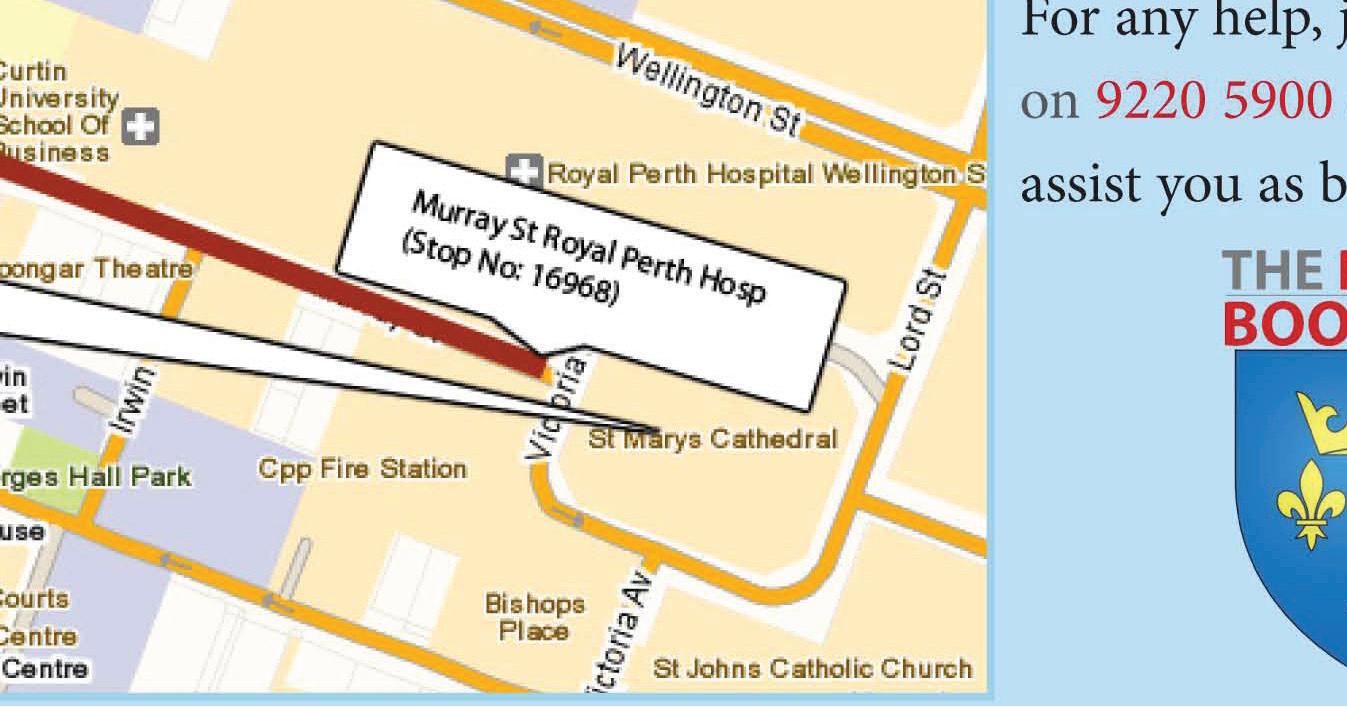
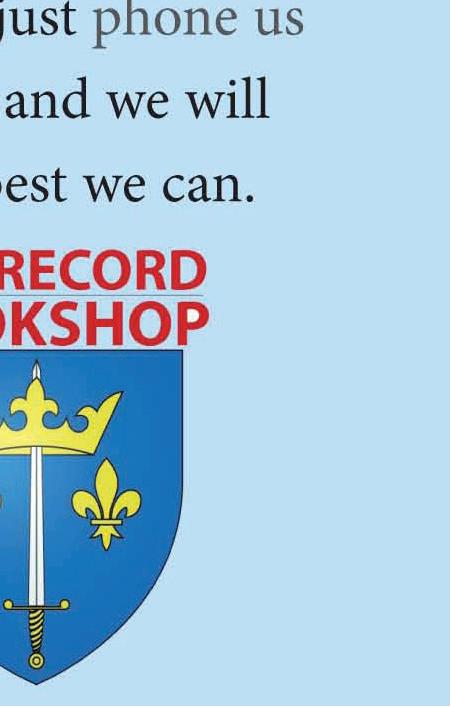
SAINT Joseph Parish and Saint Joseph School in Northam combined recently to honour Mary Help of Christians, Patroness of Australia and to recommit the parish, school and nation to her motherly care on 24 May.
The day included an ecumenical session with other denominations invited, to pray for good consistent rains throughout the coming season and a bountiful harvest.
Intercessions included the protection of the health and well being of all people in Western Australia’s
farming region. All students in the school were given a bookmark to help foster an awareness of Our Lady’s significance to Australia and encourage devotion to her as Help of Christians and Patroness of Australia.
The high school helped organise a Mass on her feast day. Later, students formed a guard of honour as the priests, acolyte and flag bearers processed to the shrine of Mary, Help of Christians. Following censing and blessing her image, flags were placed at either side of the
statue of Mary, Help of Christians with a special prayer asking for her continued intercession in protecting and caring for the Australian people and the nation. The full Rosary was prayed throughout the day, with a friendly morning tea and a DVD presentation that looked at the historical aspects of Our Lady’s help in the Church in Australia. The day concluded with Adoration and Benediction.

THE Biennial Conference of the Billings Ovulation Method, held 29 April to 1 May in Preston, Melbourne, drew delegates from around the world including men who have chosen chastity and celibacy for life - six Catholic priests.
Forty-eight international delegates from 19 nations attended as did 74 Australian delegates.
They listened and discussed over several days the unique approach to female fertility and natural family planning, which began in Australia and which has now been officially adopted by countries facing significant population issues such as India and China.
The Billings Method is still not widely understood, even within the
open
APPLICATIONS for the Archbishop Goody Award - in memory of Archbishop Launcelot
Catholic Church, but is considered to be the most accurate method known for achieving or avoiding conception in the world. It is also an Australian success story.
Beginning in the 1950s and building on the work of earlier scientists and contemporary colleagues, Melbourne couple Drs John and Evelyn Billings discovered and refined the remarkable approach based on the observable signs of female fertility.
The approach the couple developed to charting female fertility is now known almost universally simply as the ‘Billings Method’.

To the uninitiated some aspects of the conference could seem obscure; this year’s theme - Pockets of Wonder - focused on, among other subjects, the little-known but critical importance of the para-urethral pockets of Shaw in the whole cycle of female fertility.
Goody, Archbishop of Perth from 1968 to 1983 - are now open with up to $5000 available to winners.
The Archbishop Goody Award aims to further the lay apostolate in the Archdiocese of Perth by financing the formation, education and training of lay people in the apostolate. Applications for the Award must
Perth Archbishop Barry Hickey ordained three new deacons (pictured) for the archdiocese of Perth on Thursday evening 26 May before a congregation of approximately 300 people.
Around 27 clergy, together with seminarians from St Charles Archdiocesan and Redemptoris Mater Archdiocesan Missionary seminaries attended the ordinations of Wilson Donizzetti, 27, Antonio Scala, 43 and Marcello Para, 28.
All three studied at Redemptoris Mater in Morley.
Deacon Donizzetti, a former pharmacy worker in Brasilia, Brazil, has been assigned to Rockingham. Deacon Scala, a former landscape gardener from the island of Iscia, near Naples, has been assigned to Mirrabooka.
Deacon Parra, who worked in a call centre in Chile after leaving school, has been assigned to Cottesloe.
be submitted by no later than 31 July; selection of a winner or winners will be made by 30 September.
Applications can be made by individuals or groups.
The Archbishop Goody Award was originally established in 1983 by Archbishop Launcelot Goody, KBE, from proceeds of his testimonial fund, donated by the clergy
The pockets of Shaw, named after Dr Wilfred Shaw, play an at-times critical role in absorbing a key indicator of fertility, vaginal mucus; their function can also be negatively affected by a history of contraceptive use.
Other highlights of the Conference were moving tributes to the late Professor James Boyer Brown - a New Zealand-born academic, who, among other achievements, revolutionised reproductive medicine by permitting accurate monitoring of ovarian activity.
Dr Jan Hemstad from Washington spoke on the current state of scientific research into the Billings Method. An Oblate priest from Canada, Fr Joseph Hattie OMI, gave the Conference oration on how the Billings Method had enriched his
and people of the Archdiocese on the occasion of his retirement as Archbishop of Perth.
The fund became dormant in 1991 but was relaunched in 2005. The current Board has been appointed by Archbishop Barry Hickey to reactivate the Award. The Board appointed by the Archbishop to oversee the award


own priesthood. Leading Australian bioethicist and theologian, Rev Dr John Fleming, spoke on Pockets of Wonder and Church Teaching with particular reference to magisterial documents such as Evangelium Vitae, Donum Vitae and Dignitatis Personae
Reports from a number of international delegates shared some of the remarkable progress being achieved in spreading Billings Method news around the globe.
The Conference was followed by a series of training programmes on 2-5 May for new and experienced teachers of the Method and for teacher-trainers.
The Conference Mass was celebrated by six priests who were all delegates to the Conference – five of them were from overseas.
- photo courtesy of BillingsLife
is also happy to receive donations. Those wishing to support the objectives and aims of the Award by way of donations to the Fund may do so by the Chairperson of the Archbishop Goody Award. For application forms or further information phone 9384 0598 or email claremont@perthcatholic.org.au


Amonth later, it’s still worth talking about. The Royal wedding was, we were told, watched by something like a quarter of the world’s population. It was in many ways fascinating, not merely for details such as the long-awaited gown and how the couple would manage to carry it all off in front of intense global scrutiny and expectation, but also for the significance of the ceremony and what the watching global audience made of it all. It was a great ceremony and, coming in a moment when at some levels the world appears to be officially and inexorably drifting further and further away from the inheritance of belief in God, it was a surprising Christian moment. The prayer composed by the Duke and Duchess of Cambridge was simple yet full of the happiness of spousal love, sounding very much as if it was centred in gratitude for things that are really important, such as family.
The homily given by the Dean of Westminster Abbey was, one might simply and accurately say, excellent. As a homily on the meaning of Christian marriage it was the sort of composition that could go down as a textbook model for all future wedding homilists. The very first sentences delivered by the Dean are worth quoting again to get some sense of its flavour and substance: ““Be who God meant you to be and you will set the world on fire.” So said St Catherine of Siena whose festival day it is today. Marriage is intended to be a way in which man and woman help each other to become what God meant each one to be, their deepest and truest selves.” Among other observations one could make is that at the very beginning the good Dean was centring marriage in it’s author: Jesus Christ.
For Catholics there was the very pleasant, indeed gratifying, surprise of the opening reference to St Catherine of Siena, not only one of the Church’s greatest figures (she is one of only three women to be accorded the title ‘Doctor of the Church’) but also one of her favourite daughters, a woman of great elegance and beauty in every sense of the words who had uncommon courage and eventually prevailed upon a Pope to restore the papacy from Avignon to Rome.
PO Box 3075
Adelaide Terrace
PERTH WA 6832
office@therecord.com.au
Tel: (08) 9220 5900
Fax: (08) 9325 4580
In short, the Royal wedding, beyond anyone’s expectations, was Christianity and the Christian vision of marriage beamed live into the homes of a quarter of the world’s population in the most positive and affirming way.
The wedding also came shortly after the greatest celebration and moment in the Christian yearEaster. For millions of Christians around the world Easter is the joy that expresses the truth that the death and resurrection of Jesus Christ is the Christian life. This paradox bears constant repetition and meditation. At Easter we can recall, as we enter into its mystery, that in Baptism Christians die with Jesus and in our deaths we rise with Him to eternal life. The life that continues after physical death is not one, as some religions believe, that is extinguished or annihilated into nothingness and merged with the a cold and stark universe. For the Christian man and woman it is precisely the triumph of the resurrection which shows that our unique individual identities continue without loss and in fact are glorified beyond our comprehension in eternal happiness with God and all those who, as we pray in the Mass, have gone before us marked with the sign of faith. A fortnight after Easter The Record produced its special Easter roundup edition, reporting on how thousands of Christians young and old around WA came together again to recall and mourn the sacrifice of Jesus and then rejoice in the victory of His resurrection.
The third good thing to transpire last month was the beatification of Pope John Paul II on 1 May in Rome. What can one say? When Pope John Paul II died in 2005 there was a genuine outpouring of grief around the world. Two million Poles or so simply upped and left Poland, headed south for the funeral of a man who was not only their Pope but, just as importantly, their brother. This remarkable personality who dominated the world stage for three decades seemed to exhibit God’s mysterious providence at work in every aspect and at every turn of his dramatic life. Many saw in him the clearest living proof of the existence of God, the truth of Jesus Christ and the reality of a supernatural order that a person could get. He seemed more like a titan. In fact, he was a saint. Many have long quietly wondered whether he was not already effectively canonised on the spot by the sensus fidelium in St Peter’s Square in 2005 by the hundreds of thousands chanting over and over again at his funeral ‘Santo! Subito!’ or ‘Sainthood! Now!’ The actual beatification seemed, in some regards, more like a formality.
Regardless of the technicalities, millions had no problems believing that John Paul II the Great was in heaven at about the same moment of his death and the beatification received almost universal approval, with perhaps only the sad exponents of Cafeteria Catholicism looking on uncomprehendingly. Like the Royal wedding, millions around the world tuned in to watch the events in Rome unfold and those of us here in Perth who saw it had the unexpected pleasure of seeing Sr Bernadette Pike, a Perth woman who founded a women’s religious congregation known as the Missionaries of the Gospel, give the second reading at the official beatification Mass presided over by Pope Benedict XVI.
The significance of the beatification lay in many things but, most importantly it was always about one thing or, one should say, about one person: Jesus Christ. But of course in a spectacular way it was still the beloved Pope John Paul II’s day as well. And it was also yet another teaching moment, a Christian moment, a moment when Catholics could justifiably recall that despite the sometimes spectacular failings of many in the Church, despite the ridicule of popular culture, the truth of the Gospel always stands firm. Looking back in this way, one can honestly say that it was a month of very good things.

JOHN Fahey was born on 3 October, 1883 at Rossmore, Co. Tipperary. He was educated at Mt Melleray and at Genoa.
He was ordained on 25 May 1907 and arrived in Perth on 7 December of that year.
He joined up on 8 September 1914 as a Chaplain and was assigned to the 11th Battalion. He reached Gallipoli on 25 April 1915. He was mentioned in dispatches and was awarded the DSO for “gallantry under fire”. After the war he spent most of his priestly life at Kellerberrin and Cottesloe. He died on 28 April 1959 and an estimated 2000 people attended his funeral.
He wrote this letter to his father in Ireland:
Gallipoli Peninsula 24/5/1915
My Dear Dad,
Though I have been through more than four weeks of war I am still hale and hearty and without a scratch. Having escaped so far I do not think I can get hit now. The Mediterranean army composed of English, French, Australians and New Zealanders was landed in Gallipoli on 25th April. Part of it was landed at the Southern and the Australians about ten miles to the north. As the English advance from the south sweeping the Turks before them we shall unite and form the left wing of the force.
We landed in the face of fierce opposition from the Turks who seemed to be waiting for us. As we were in the boats nearing the shore a terrible hail of fire from rifles, machine guns and artillery greeted us. Many were killed and wounded in the boats and many more on the shore. I saw men fall around everywhere. It was our first experience of fire and it was sudden and terrible. The Turks were in a strong position on a hillside where they commanded the whole beach.
As quickly as our fellows reached the shore they fixed bayonets, gave a wild cheer and rushed the hill. A terrific battle ensued. Our fellows literally dug the enemy out of their trenches and holes and in a short time had them on the run.
By seven o’clock in the morning the hills commanding the shore were cleared. The battle began at 4.30 in semi-darkness. All day the battle raged and by night our men had secured a safe footing and began to entrench themselves. I never

expected to see anything so exciting as that wonderful charge of the Australians. They are splendid fellows and dashing, reckless soldiers. It was however, a costly business. Many hundreds of dead and dying men were lying on the shore and on the hillsides before the day was over. The brigade to which I belong was selected for the landing party as it is supposed to be the best brigade in the Division. The task was a difficult one but they did it well. My battalion lost nearly half its strength. The coast being clear the disembarkation of the corps was proceeded with, and in a few days all our infantry and artillery was ashore. The guns have to be hauled by men to the summit of the hills as they were too steep for horses. I have seen as many as 200 men hauling a gun up the hills, while the engineers went ahead improvising a road and throwing up bridges. Once we got our guns into position, we gave the Turks a taste of what they gave us in the landing. We now hold the narrow strip of territory along the shore, but we are so well entrenched that the position is like a fortress. Being such a small area it is swept by the Turkish artillery, but the hills provide good cover. Nevertheless a person has to be careful in the day time. The Turkish artillery are silent at night. For the past two weeks they raked the place with shrapnel, but lately they are very quiet. Probably they are short of ammunition and are sparing it. They made several counter attacks during the first days, but they were all a failure. If they succeeded in driving us back we would be in a bad plight for we have nowhere to retreat to except into the sea. On the 18th they made a supreme


effort. They must have thrown at least 20,000 men against the whole of our line. The result was they had 3000 killed and perhaps 10,000 wounded – sweet revenge for our losses in the landing. It was fearful slaughter; the battle began at 8 in the morning and continued without intermission till the following midday. The Turks are brave men but no good at an attack. They came on to our trenches in massed formation – German style – a dense column only to be mown down by the rapid fire of our rifles and machine guns.
When day broke our artillery joined in the fray and did awful havoc. I was often in the trenches and had a good view of the slaughter. Our men were wild with excitement. Rifles were hot from continuous fire; men were almost fighting for loopholes and would not leave the trenches to have breakfast until the battle was over. When it had finished the sight in front of our trenches was awful. Dead and wounded Turks were lying in heaps and our machine gunner paid off 30,000 rounds in a few hours and he counted in front 500 corpses. I do not think they will attack again. The dead were not buried for a week and the stench of dead Turks was terrible. Needless to say I have had some narrow squeaks especially in the first few days. I shall tell you all about them when I come home. I need not have come ashore the first days. Chaplains were asked to remain on the ships for the first day or two, but I was anxious to be in the fire, so I came away with my battalion, and was in the first boat to touch the Turkish shore. It was fortunate that I did come ashore for many a dying Catholic needed my services; I was the only priest ashore the first day. Now we have five or six.
You have no occasion to worry about me. I am feeling fit and well. The position is fairly safe now, and if a person is careful, he will not be hit, and you can trust me to be careful. Food is good and plentiful but not too varied. It is mostly bully beef, biscuits and black tea. We sleep in holes or dug outs in the ground. They are more or less like a grave, and are shrapnel and bullet proof. When night comes I spread out my waterproof sheet, roll myself in my greatcoat and blanket and sleep like a top. It is a rough life, but it does not affect me and I feel quite well. I have not had my clothes or boots off for five weeks except to have an occasional swim, and I have four weeks beard on me. I wish you saw me. Now for goodness sake do not worry about me. I shall get through this business all right; and shall have a lot of stories to tell when I come home. With love to yourself and all the family, and hoping that you are all well,
I remain
Yours very sincerely
John
Civil unrest in Cairo and demonstrations in Syria were not enough to stop a band of Perth pilgrims from seeing the Holy Land...
BY C HRIS O LNEY AND PETER KENNEDYThirty-four pilgrims from across Perth have just returned from a 17-day visit to the Holy Land, visiting sacred sites, following in the footsteps of Jesus and virtually rubbing shoulders with heavily armed security forces patrolling Israel’s borders and potential trouble spots within that country.
But the pilgrimage was effectively trouble free after incidents in the region earlier this year led to a major reorganising of the itinerary. There was risk at one stage that the event might even have to be cancelled.
Egypt was to be the original starting point, but had to be dumped after riots in the major cities, including Cairo, which saw the overthrow of the country’s long serving dictator, President Hosni Mubarak.
Then Syria had to be omitted after demonstrations there, especially in the capital of Damascus, which resulted in a number of deaths. Dean of St Mary’s Cathedral Monsignor Michael Keating led the pilgrimage, which went direct to Amman, the capital of Jordan, which turned out to be an idealand relatively tension free - starting point.
One of the early highlights was a
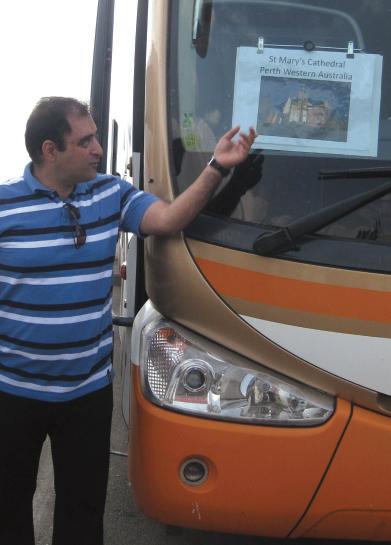
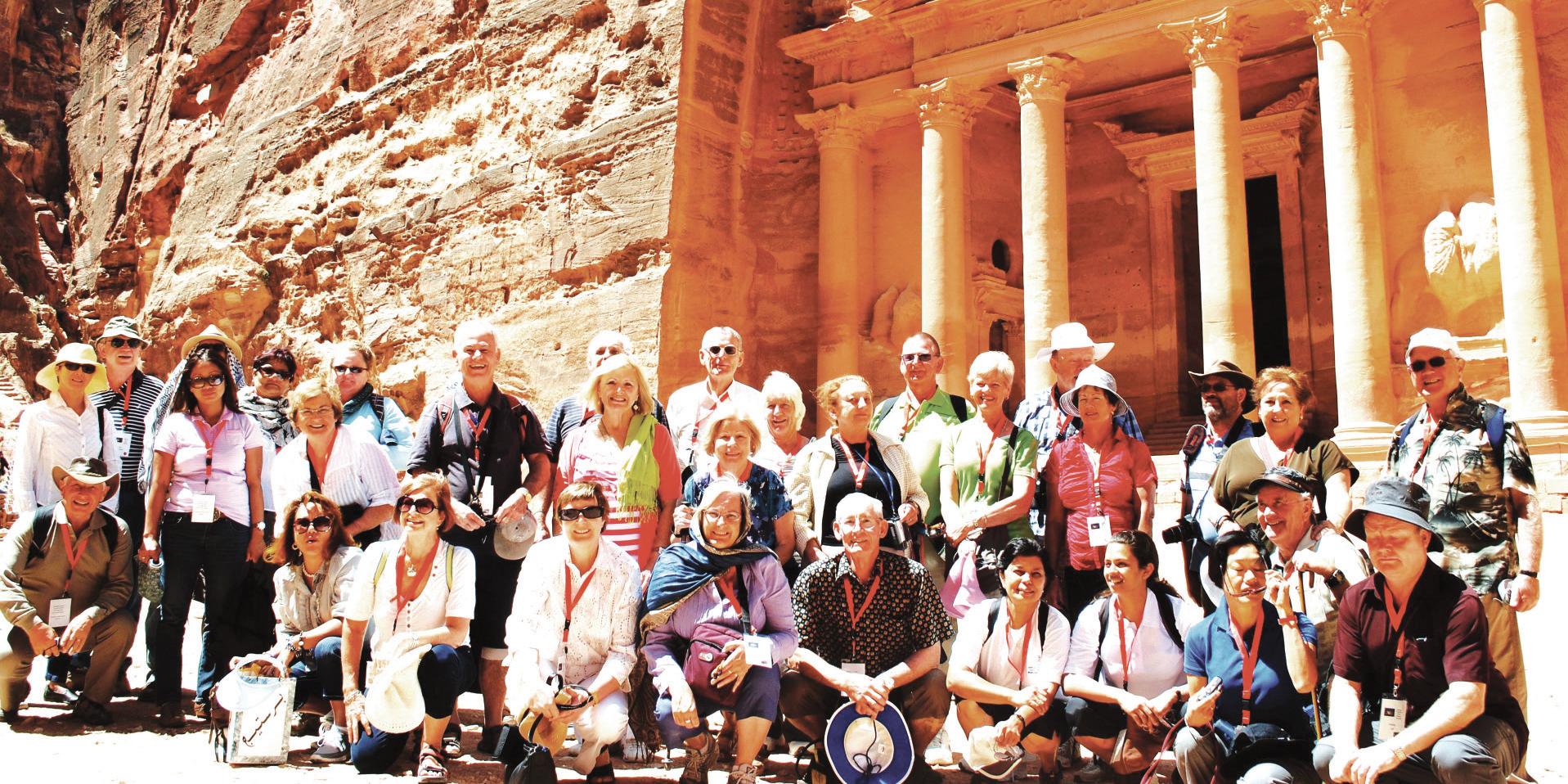
visit to Mt Nebo, with breathtaking views. Franciscan Brother Cassiusoriginally from Broken Hill - was a genial host, explaining how Moses had looked out over the Promised Land to Jericho, but never got there. We made it to Jericho, considered the oldest and “lowest” city in the world. It was one of our first ports of call after crossing into Israel at a border controlled by heavily armed Israeli soldiers.
Married pilgrims renewed their wedding vows at Cana, where Jesus performed his first miracle, turning water into wine. Then it was off to Nazareth, where the Holy Family was based for almost 30 years, the Sea of Galilee and the miracle of the loaves and fishes, and Bethlehem, where Jesus was born. One of the
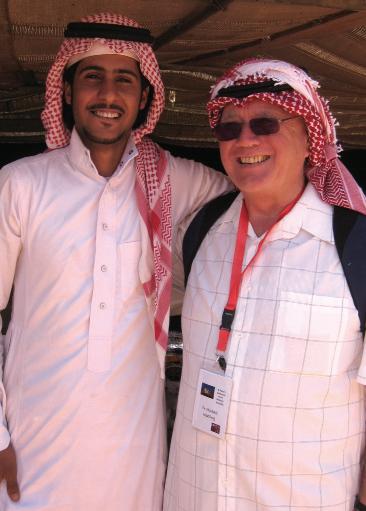
highlights was the Way of the Cross in the Old City of Jerusalem. We made a 7am start to beat the crowd, following in Our Lord’s footsteps along Via Dolorosa to the Church of Calvary. Pilgrims took turns in carrying a cross as a reminder of the terrible suffering and death Jesus endured, as they traversed the 14 stations.
Pilgrims also joined with Jews to place notes containing their intentions in the Wailing Wall, and visited the famous Dome of the Rock Mosque on Temple Mount. There were some light hearted moments, including a visit to the Dead Sea, where pilgrims experienced for the first time actually floating in the densely salty water, in which it is impossible to sink. But soldiers armed with sub-machine guns were on hand, patrolling the beach.
Mgr Keating ensured that the focus of the visit was kept on track with daily Mass, assisted by Deacon Bruce Talbot, from Bateman. Mass was said in some memorable locations, including the remains of a Byzantine church at Masada on a desert mesa rising high above the Dead Sea. The Rosary was recited on extended bus trips.
That the pilgrimage occurred at a time of heightened tension, along with the focus of world attention linked with a significant speech on the Middle East by US President Barack Obama, only added to the rich experiences of the occasion. Security was tight, but a judicious arranging of the itinerary, with the aid of experienced local guides, ensured there were no untoward incidents.


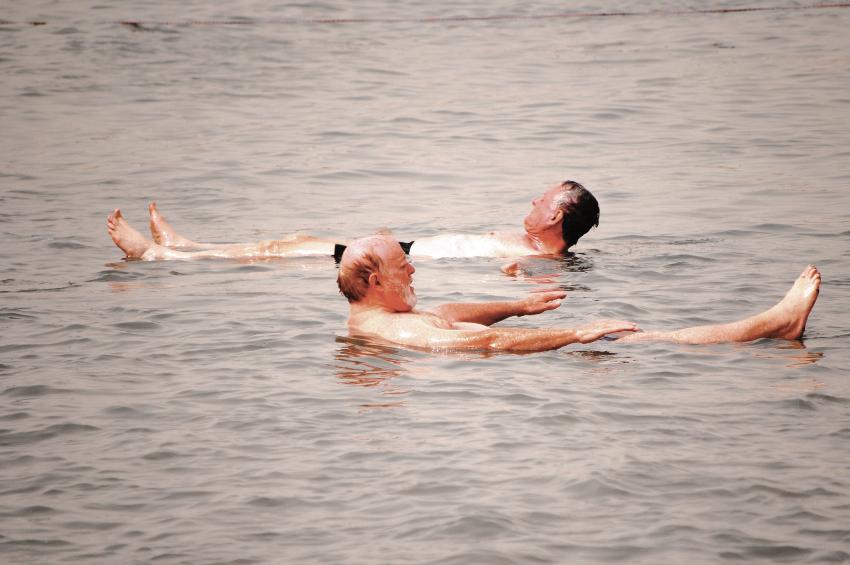
 A group shot, above, outside the treasury at Petra; Mgr Keating celebrates Mass at Masada, below, with Deacon Bruce assisting. PHOTOS: CHRIS OLNEY AND JEREMY LOGAN
Pilgrims, above, float in the salty Dead Sea; Pilgrims, below, carry the Cross along the Via Dolorosa (l-r) Amanda Adriansz, Chris Olney and Margaret Czerwionka.
The pilgrim tour’s driver, Solomon, with bus, above left; Mgr Keating, above right, and Bedouin friend at Wadi Rum, Jordan.
A group shot, above, outside the treasury at Petra; Mgr Keating celebrates Mass at Masada, below, with Deacon Bruce assisting. PHOTOS: CHRIS OLNEY AND JEREMY LOGAN
Pilgrims, above, float in the salty Dead Sea; Pilgrims, below, carry the Cross along the Via Dolorosa (l-r) Amanda Adriansz, Chris Olney and Margaret Czerwionka.
The pilgrim tour’s driver, Solomon, with bus, above left; Mgr Keating, above right, and Bedouin friend at Wadi Rum, Jordan.
Bringing one of Perth’s architectural treasures back from the brink of disrepair and decrepitude was not without its difficulties - but it was also a labour of love and well worth all the effort.
SAINT Mary’s Cathedral Presbytery was designed by architect and builder James Manning (Clerk of Works for the Convict Establishment 1850 -1862) and built in 1855-56 as the Episcopal Palace by Joseph Benedict Serra, a Spanish Benedictine monk, Coadjutor to Bishop Brady and Apostolic Administrator of the Diocese of Perth from 1851 to 1862.
It was then a three-storey stone construction with a basement and had a shingle roof in a simple Georgian style.
At the time it was the largest building in Perth. Joseph Ascione, a Benedictine novice and trained mason from Naples, played an important part in building the Episcopal Palace and later, in 1865, the Cathedral of the Immaculate Conception (now St Mary’s Cathedral).
This Georgian style was maintained when a two-storey verandah was added at the northern elevation for Bishop Matthew Gibney (Perth’s third Bishop 1886-1910) although the exact date and builder of this first renovation is unknown (before c 1890).
Joseph Denis Nunan (a trained carpenter and Fenian transported

The western wall of the entrance foyer holds a repaired bas relief which would have been commissioned by Bishop Serra, Apostolic Administrator of the Diocese of Perth from 1851 to 1862, who commissioned the Episcopal Palace in 1855.
The pontifical hat at the top, a galero, has been a common motif in ecclesiastical heraldry since the fifteenth century.
It is used to symbolise church hierarchy; the colour of the hat and number of tassels indicate the cleric’s place in the hierarchy. Suspended from the galero on different coloured cords are fiocchi (tassels) on either side.
They are suspended in rows of one, two, three, four and five. Generally, priests have a black hat with black cords and tassels, Bishops use a green hat and cords and six green tassels (suspended in rows of one, two and three) on each side, archbishops likewise use a green hat and cords but with 10 green tassels (suspended in rows of one, two, three and four) and cardinals have a red hat and cords and 15 red tassels (suspended in rows of one, two, three, four and five).
The 6 tassels on either side signify that the house is overseen by a bishop. The patriarchal cross bearing the Benedictine motto “pax” identifies the building as a Benedictine community at that time. The palms are a symbol of victory and crossed palms generally signify Christ’s victory over death.
to Perth in 1868 – he received his free pardon in 1869) was used by Bishop Gibney to do some work at the Bishop’s Palace around this time but there is no evidence that he was the builder of this addition.
In 1911-12 the first major alterations and additions were carried out for then Bishop Patrick Clune, Perth’s fourth Bishop from 1911 and later the first Archbishop from 1913 to 1935.
These additions, done by builder William Fairweather, followed the design of architect Michael Francis Cavanagh and changed the Bishop’s Palace giving it a Federation Italianate styling.
In March 1912, as the alterations and renovations approached completion, the ladies of the St Vincent de Paul Society of the Cathedral Parish held a ‘kitchen and linen’ tea so that members of the laity could contribute to furnishing the Bishop’s Palace and The Record reported on 16 March 1912 that “many fine and useful gifts” were received as a result.
The Record reported on 15 June 1912, as the finishing touches were being completed, that the “former eyesore” was “now a building of beauty to compete with anything in Perth”.

From 1913 the residence was referred to as the Archbishop’s Palace. Further alterations and additions were then made in 1938-39 for Archbishop Redmond Prendiville (Archbishop from 1935-1968) by Berry Bros (builders) following a design by architects Howard Bonner & Tracey. This last set of works extended the building, adding an administration wing in the same style as the previous eastern extension including the roof line balustrade. The verandah on the northern side had a second floor added with balustrading and the ground floor verandah was built in to make offices. The 1939 renovations were the last significant additions to the
Archbishop’s Palace. Minor changes have occurred since then including converting part of the basement for accommodation (early 1950s) and a new roof in 1956 that removed the roofline balustrading.
The exterior was painted its cream colour (formerly grey) in preparation for the visit of Pope John Paul II who stayed there overnight on 30 November 1986.
In April 1978, the Archbishop’s Palace was Classified by the National Trust, and it was entered on the Register of the National Estate in October 1980.
The Archbishop’s Palace was included in the State Register of Heritage Places in 1996 given its significance as a component in the Victoria Square precinct as well as

for its association with the Roman Catholic Church; it is one of the oldest surviving Episcopal residences in Australia.
In 2008, at Archbishop Hickey’s request, the name of the Archbishop’s Palace was changed to Cathedral House.
By 2008, the condition of the Archbishop’s Palace had deteriorated and major repairs were needed as illustrated by the pictures below.
Philip Griffiths Architects were invited to prepare options for making the place the Archbishop’s home once more and to bring the whole of the place up to suitable standards for the clergy and guests. The project was undertaken to coincide with the conservation and completion of St Mary’s Cathedral. The work was
undertaken by Colgan Industries and included the removal of ad-hoc furniture, fit-out and services introduction, conservation of the exterior, a sub-basement car park and garden terrace, conservation of the boundary walls, the addition of a caretaker’s unit in the basement and the upgrading of the building interior to contemporary accommodation standards.
During the project a number of discoveries were made that highlighted the distressed and run-down nature of the house prior to the project and reinforced the need for the major repairs to be undertaken if only for the safety of the residents.
Two examples were the inadequate foundations below the main entrance off Hay Street and the rusted beams
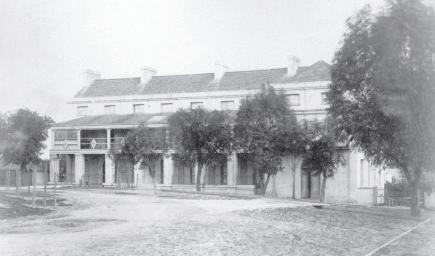 Completed: the refurbished Cathedral House seen at evening, above, facing Hay St in Perth’s CBD. In the foreground is the courtyard wh for residents and staff.
Changing with the years: The Bishop’s Palace, left, in 1861-62. The-then St John the Evangelist Cathedral (now St John’s Pro-cathedral) built in 1843-46 and the Sisters shows the Bishop’s Palace thirty years later in1894. This northern elevation shows the added verandah. The door to the right was later removed and replaced with two
Completed: the refurbished Cathedral House seen at evening, above, facing Hay St in Perth’s CBD. In the foreground is the courtyard wh for residents and staff.
Changing with the years: The Bishop’s Palace, left, in 1861-62. The-then St John the Evangelist Cathedral (now St John’s Pro-cathedral) built in 1843-46 and the Sisters shows the Bishop’s Palace thirty years later in1894. This northern elevation shows the added verandah. The door to the right was later removed and replaced with two

that held up the concrete balconies. Notable features include the conservation of the main spaces such as the dining room and ‘Chapter Hall’, the installation of a steel frame glass lift in the main entrance foyer, the reinstatement of former balconies to contemporary detail, the creation of a small number of suites in place of the previous priests’ ‘cells’ and conservation of a number of other authentic spaces.
The work involved providing new centralised air-conditioning, upgrading lighting, power and communication services and the provision of new sanitary facilities to individual suites to greatly improve the useability of the building, all of which placed quite a demand on the

designed to run in existing cavities or a small number of new ducts and concealed by new ceilings, all fed off an external service compound. This required substantial design and on-site review to ensure the significant building fabric was not compromised.
Where the imposition of new items, such as the lift, has occurred, these have been done in a transparent nature and affected significant built fabric has been re-presented and interpreted to remark of this process.
The new lift frame was constructed off-site and lowered, through the roof, in one piece.
In addition, evidence of pencil marbling, original brickwork with timber lintels and cement render from previous building campaigns were located, conserved and presented for interpretation.
The new sub-basement car park is set at a level so as not to obstruct the view of the building from Hay Street, and with careful landscaping is camouflaged, leaving the glass balustrade from the garden terrace, the two mature palms and the olive tree to draw the eye. The exterior has



scrape investigations, to a colour to match that when it was first painted in 1986, in time for the visit of Pope John Paul II. Though substantial, the project is the refurbishment of both a private house and the official offices of the Archdiocese of Perth.
This has been done to make the building more comfortable and useable to its current and future residents and office workers.
It is the most significant work to occur to the building since the 1939 building phase and seeks to unify the place for its future inhabitants.
The completed work is a credit to the architect Philip Griffiths (project architect Alistair Ravenscroft) and the builder Martin Colgan and sons Nathan and Daniel (site manager Dean Tierney).
These photographs of parts of Cathedral House taken before repairs commenced give some idea of the extent of age-related decay: metal beams holding up sections of the roof and verandahs are almost completely rusted through in places.

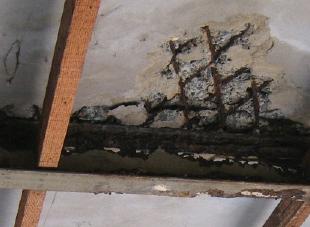
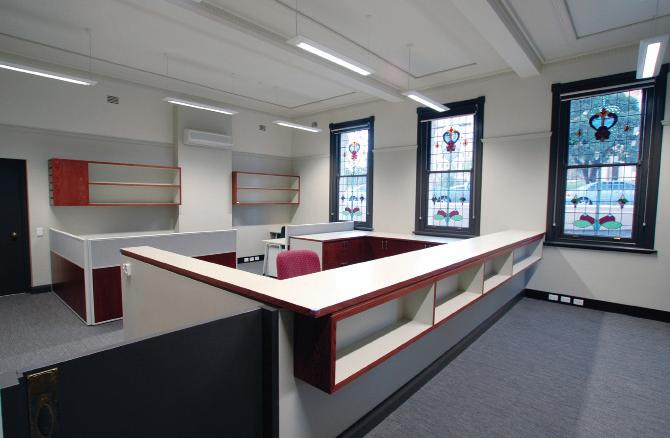

 hich also covers a camouflaged underground carpark
hich also covers a camouflaged underground carpark
Oblates celebrate 150th anniversary of founder St Eugene de Mazenod’s death
MAY 21 this year marked 150 years since the death of the Oblate founder, St Eugene de Mazenod.
Born into a noble family in Aix en Provence, France, Eugene had a privileged life up until the French Revolution when his family were dispossessed of their home, forced into exile and fled to Italy where he stayed for 11 years, during which time he was tutored by Don Bartolo Zinelli, a priest who introduced him to the Ignatian spirituality and opened to him a vision of Jesuit overseas missionary endeavours, in China particularly.
Eugene returned to France in 1802; his parents had divorced, his father choosing to remain in Sicily. However, any thoughts of a priestly vocation sparked by Don Zinelli 10 years earlier had all but disappeared in young Eugene thanks to a hectic social life.
Several years later he felt an emptiness amid all the frivolity and began searching for something more in his life.
During the Good Friday liturgy in 1807 or 1808, Jesus’ sacrifice and ransom of each soul profoundly struck the young Eugene.
He was overwhelmed with tears of sorrow for having done so little in his own life to respond to Jesus’ sacrifice while crying tears of joy at the revelation of God’s unconditional love.
It was a profound experience and Eugene entered the seminary shortly afterwards at St-Sulpice.
On 21 December 1811, family friend and Bishop of Amiens, JeanFrancois de Demaldox, ordained Eugene at Amiens.
The new Fr Eugene politely declined the Bishop’s invitation to be his Vicar General which would have led to a rapid rise within the episcopacy.
Instead, he became convinced that he had been called to evangelise the most abandoned – the poor, the youth and prisoners - and that it was important for him to remain free of parochial and administrative structures.
Preaching from the Church of the Madeleine, Eugene spoke to the poor, artisans, servant girls, beggars and workers in their native Provencal – the language of the common people - and conducted Mass at times so that the workers could attend. For the first time, the poor understood. His message to the poor was: “Come now and learn from us what you are in the eyes of faith”.
Aware of Napoleon’s campaign to de-Christianise, Eugene also considered all young people – rich and poor – as among the most abandoned. In Aix, he founded a Sodality of Christian Youth despite

Napoleonic laws forbidding meetings of any kind.
By 1817, in less than two years, there were 300 members. The young Fr Eugene also volunteered to serve as prison chaplain, visiting the inmates of the city’s jail almost every day, striving to instruct, encourage and convert them. His actions ran counter to the prevalent practice among the clergy of Aix. For example, it was customary throughout France at the time to refuse the Eucharist to prisoners condemned to death. The young Fr Eugene turned that way of thinking on its head.
Not only did he give communion to the condemned person, but he would celebrate Mass especially for them in their cell. There, he gave them Holy Communion and accompanied them to the scaffold, staying alongside them through their final moments.
At the same time, Napoleon’s farranging wars had brought captured soldiers to France from all parts of the Europe; 2,000 of them were held in Aix. Shortly after their arrival, a typhus epidemic ran through the overcrowded camp. Many died, among them the chaplain, and Eugene offered to take his place. Soon he too contracted typhus and hovered near death, but his health was restored through prayer.
On 25 January 1816, he founded a new congregation of Religious men – the missionary Oblates of Mary Immaculate. On Christmas Eve 1837, he was ordained Bishop of Marseilles and later Archbishop
of Marseilles. Although he had a strong allegiance to his native France, his vision for his Order was Catholic in the true sense of the word because, by 1841, he had sent missionaries to England, Canada, Ceylon and Texas in 1848 and Natal in 1851.
At the time of his death in 1861 there were six Oblate Bishops and more than 400 missionary Oblates working in 10 countries.
On 19 October 1975 Eugene was beatified by Pope Paul VI and Pope John Paul II canonised him on 3 December 1995.
In 1894, four Oblates from Inchicore in Dublin arrived in Fremantle, WA to continue Eugene’s charism and to work among the poor, with youth and prisons.
Today there are Oblates working in every state of mainland Australia, with Oblate Colleges in Victoria, WA and two in Queensland, Oblates working as chaplains in prisons, hospitals and schools in three states, the Oblate Youth programme and Rosies outreach programmes for homeless and marginalised people are expanding.
Today the Australian Province includes a strong Hong Kong Delegation where significant work is being done by Oblates in orphanages.
The Oblates’ current vocations coordinator is Fr John Sherman, former Rector of the Basilica of St Patrick in Fremantle. Now based at Mazenod College in Lesmurdie, he can be contacted on 0418 825 701 or email vocations@oblates.com.au.

OBLATE Vicar Provincial
Fr John Maher OMI has died suddenly on 28 April at Caritas Christi in Kew just 23 days after being diagnosed with inoperable cancer. Fr Maher was farewelled at a Vigil Mass on 4 May presided by current Oblate Provincial Fr Harry Dyer OMI, with the homily preached by his close friend and fellow Oblate Fr Vincent Ryan OMI. Fr Maher was a member of the Provincial Council, parish priest at Our Lady of the Immaculate Conception in Sunshine, lecturer and Head of the Philosophy Department at the Catholic Theological College, a member of the Melbourne Archdiocese Senate of Priests and a previous Formator and Rector of St Mary’s Seminary for more than 20 years.
Fr Dyer OMI noted that the liturgy at the Vigil Mass was “prayerfully participated in by all those present”, including some 43 Religious and diocesan priests. The following day, a Requiem Mass for Fr John was held at St John Vianney’s in Springvale North, with hundreds of mourners, including Oblates from around Australia, up to 93 diocesan priests and Religous, more than 50 seminarians from St Mary’s and Corpus Christi College, past and present parishioners, Fr Maher’s brother Michael and his two sisters Anne and Maureen.
They were led in an “uplifting and reflective” service by Fr Tony Maher OMI, Fr John’s younger brother. Joining the many Oblate concelebrants on
the altar was retired Bishop Jerry Coffey of Sale.
Born in Warragul, Victoria in 1949, Fr John entered St Mary’s Seminary in 1972, taking first vows in 1973 and was ordained on December 18 1976.
His first appointment was to the Oblate parish of Immaculate Heart of Mary in Sefton, New South Wales, followed by five years at Iona College in Queensland, one year at Mazenod College in Mulgrave, Victoria then St Mary’s seminary which was his focus for the next 23 years. In 2006 he was appointed Assistant Parish Priest at St John Vianney’s in Springvale, Victoria and in 2008 he was appointed parish priest at Our Lady’s in Sunshine, Victoria.
A former pupil of Fr John and current MAMI Director, Fr Christian Fini OMI, recalled how, on Fr John’s final day, he warmly received many visitors and, although they left saddened by what was happening, Fr John managed to extend the peace and acceptance of the situation to those who visited him.
“Fr John was a great teacher throughout his priestly ministry but his greatest lesson was his total trust and faith in God as he journeyed the last 23 days of his life,” Fr Christian said.
“Like the followers of Jesus who found the empty tomb, we feel an acute sense of the emptiness in the sight of this loss but we have the advantage of their experience of the Resurrection and know that Fr John placed his life in God’s hands in a certain hope of his own sharing in the Glory of the Resurrection.”
The Oblates have some major operations in WA, including Mazenod College in Lesmurdie and the Basilica of St Patrick in Fremantle.
VATICAN CITY (CNA/EWTN News) - Pope Benedict stressed the urgency of evangelising modern society, saying that Christians today face the task of reaching a world that grows increasingly apathetic to the message of the Gospel.
“The crisis we are living through,” he said, “carries with it signs of the exclusion of God from people’s lives, a general indifference to the Christian faith, and even the intention of marginalising it from public life”, the Pope told members of the
Pontifical Council for Promoting New Evangelisation on 30 May, as they prepare for their 7-28 October 2012 synod where Bishops and others will discuss the late Pope John Paul II’s vision of proposing the Christian faith in new ways.
Pope Benedict explained that “the term ‘new evangelisation’ recalls the need of a new way of evangelising, especially for those who live in a situation like today’s where the development of secularisation has left deep marks on even tradition-
ally Christian countries.” He noted that “proclaiming Jesus Christ, the sole Saviour of the world, is more complex today than in the past, but our task continues to be the same as at the beginning of our history. The mission hasn’t changed, just as the enthusiasm and courage that motivated the apostles and first disciples should not change.”
The Church’s message, he said, “needs to be renewed today in order to convince modern persons, who are often distracted and insensitive”.
“That is why the new evangelisation must find the ways to make the proclamation of salvation more effective, the salvation without which life is contradictory and lacking in what is essential,” he said. He observed a growing phenomenon of people in modern society “who wish to belong to the Church but who are strongly determined by a vision of life that is opposed to the faith is often seen. It is important to make them understand that being Christian is not a type of outfit that
one wears in private or on special occasions, but something living and totalising, capable of taking all that is good in modernity.”
He emphasised that the entire Christian community “is called to revive the missionary spirit in order to offer the new message that persons of our times are hoping for.”
The “lifestyle of believers needs real credibility, as much more convincing as the more dramatic is the condition of the persons to whom it is addressed.”
A little-known lastminute visit by Padre Pio to a little-known image of Jesus
 BY PAUL MACLEOD
BY PAUL MACLEOD
In September 1968, Padre Pio’s life was nearing its end. He was 81, and for two months he had not been well. But 20 September was the 50th anniversary of his receiving the stigmata, and his prayer groups had gathered at his friary at San Giovanni Rotondo to celebrate that event.
He offered Mass that day, but was unable to the following day. However, he gathered the last of his strength on Sunday, 22 September, to offer Mass in a church packed with pilgrims.
At the end, he nearly collapsed and had to be helped from the altar.
A little earlier that morning, a fellow Capuchin and friend of Padre Pio, Fr Domenico da Cese, went to open the church at Manoppello, more than 200 kilometres away to the north, in the province of Abruzzi. Inside the church he found Padre Pio on his knees, his head in his hands, before the image known as the Holy Face.
Padre Pio said to him: “I do not trust myself any more. Pray for me. Goodbye until we meet again in Paradise.” Within 24 hours, Padre Pio died in his cell in the friary at San Giovanni Rotondo.
Padre Pio was known for his not-infrequent bilocation – being in two places at once – even attending the canonisation of St Therese of Lisieux in St Peter’s basilica in 1925.
Pope Benedict XVI was to visit the image at Manoppello nearly 40 years later, but by a more mundane method of transport, by helicopter.
But why did Padre Pio and the Pope choose to visit the Holy Face?
Since 1660, the church at Manoppello has contained an ancient piece of a rare cloth known as byssos, or sea-silk, a gossamerthin and transparent fabric woven from fibre from mussels, once used in Egypt to cover the faces of dead Pharaohs.
This cloth bears the image of the face of a bearded man with open eyes, a slightly opened mouth and a bruised left cheek. It was believed locally to be what was once known as the Veil of Veronica.
In St Peter’s Basilica in Rome, one of the four massive columns supporting the dome has long been


known as the “Veronica pillar”. It features a statue of Veronica with a cloth bearing an image of the face of Christ and a bas-relief of an angel also displaying the image.
Within the pillar is a treasury in which is kept what is claimed to be the cloth with which a woman named Veronica wiped the face of Jesus on His way to Calvary.
This cloth, contained in a reliquary and shown to the people in St Peter’s on Passion Sunday each year, is black with brown areas and no visible image. It was placed in the pillar in 1625 by Pope Urban VIII.
Where did it come from?
Well, the existence of a portrait of Christ “not made by human

hands” had been known since the sixth century, and from 705 it had been kept in its own chapel in the old St Peter’s, built by Constantine. It became known as the vera eikon , or “true image”, and the name “Veronica” appears to have been applied in the Middle Ages to a woman whom Blessed Anna Catherine Emmerich names as Seraphia in her account of her visions of the Passion.
How did it get to Rome?
This question is discussed at length in a recent book (on sale at The Record Bookshop) by a German journalist, Paul Badde. He suggests that the cloth was, in fact, “the napkin which had been on His
head, not lying with the linen cloths but rolled up in a place by itself” (Jn 20:7).
Badde recalls a tradition that a cloth with the face of Jesus was taken by the Apostle Jude after the Ascension to King Abgar of Edessa, a prominent city at the time, some 600 kilometres from Jerusalem and now known as Urfa, in Turkey. The king was immediately cured of an illness that had kept him bedridden.
Another very old tradition says that the Greeks who came to Philip asking “to see Jesus” (Jn 12:21) had been sent by Abgar. The cloth apparently remained in Edessa, and was hidden in the city wall when the city was under attack. It was rediscovered in 525 and taken to Constantinople, then to Genoa and finally to Rome.
So what is the cloth at Manoppello? As already stated, the “image” now kept in the pillar in St Peter’s was placed there in 1625, after rebuilding work.
But it was – it seems – not the image that had been venerated there for centuries. It had disappeared, probably in 1506, stolen from the frame in which it was held by two sheets of glass. The frame, broken glass and all, is still to be seen in the treasury at St Peter’s. (There are fragments of glass in the cloth at Manoppello.)
Interestingly, Pope Urban VIII promptly issued a decree ordering
the destruction of any copies of the “Veronica”, unwilling to admit that one of the most precious relics in Christendom had vanished.
Meanwhile, an anonymous pilgrim arrived in Manoppello in 1508 with the cloth wrapped in a package and gave it to a Dr Leonelli who was sitting on a bench in front of the church. He went into the church and unwrapped it, but on going out he could not find the person who had brought it. The cloth remained in the Leonelli family and then passed to another doctor who gave it to the Capuchins, who have held it ever since.
Badde points out in his book that the dimensions of the cloth at Manoppello mean it would not fit in the frame now used in St Peter’s to hold what certainly appears to be a forgery.
Perhaps because of the fact that St Peter’s still has what is purported to be the “Veil of Veronica”, little attention had been drawn to the image at Manoppello.
But Fr Domenico da Cese believed it should be better known, and in 1977 he took a large photograph of it to a Eucharistic congress in Pescara, the nearest large centre. Then things started moving.
A journalist from Switzerland wrote an article about it, which came to the attention of a Trappistine nun in Germany, Sister Blandina Schömer. Fascinated by the image, she obtained permission to move to Italy and devote herself to research on it, which she has continued up until the present.
Meanwhile, Fr Domenico had gone to Turin in 1978 for an exposition of the Shroud there, and was killed when he was struck by a car after leaving the cathedral.
He was reputed to have the stigmata and cures have been attributed to his intercession, so that moves are now being made to begin the Cause of his beatification.
The principal findings of the research by Sister Blandina and others are that:
● the cloth is so thin and delicate it would be impossible to paint on it;
● the image is visible from both sides;
● when superimposed on the image of the face on the Shroud of Turin, the image of Manoppello matches exactly.
The conclusion is that the Holy Face of Manoppello is very likely the cloth “rolled up by itself”, found by Peter and John in the tomb on the first Easter morning.
The visit to Manoppello by Pope Benedict XVI in 2006 was the first journey of his pontificate inside Italy upon which he himself had decided. His homilies have increasingly contained references to the Face of Jesus.
And Padre Pio, canonised in 2002? Did he make one last visit to look upon the Face of the Man whose wounds he had borne for 50 years before entering into the eternal vision of his glorified Lord?
- Paul MacLeod is a former journalist, now based in Geelong


“CATHOLOCISM could not exist without a Marian character,” Pope Benedict XVI told a visiting German delegation on 28 May, adding that he had realised at an early age that “being Catholic meant belonging to Mary.”
The Holy Father was speaking to members of the Maria Verkündigung, the Marian Congregation of Men, from Regensburg. They were visiting the Vatican to celebrate the 70th anniversary of the date when the Pontiff, as a young man, had been inducted into that congregation. At the time Europe was in “a dark age,” under Nazi rule, the Pope recalled. “It seemed that the continent was in the hands of this power that … put the future of Christianity in doubt.” Shortly after he entered the congregation, the war began and the group was scattered.
Today, the Pope observed, there are 40,000 members of the Maria Verkündigung in Bavaria. “Thank you all for continuing to hold this witness high,” he said, adding that their witness helps to prove that the Catholic faith is not a matter of the past but a living institution that will be powerful in the future as well.
NEARLY 53 per cent of voters in Malta - one of the world’s few officially Catholic nations - voted in favour of the legalisation of divorce in a 29 May referendum.
“Even though the result is not what I wished for, now it is our duty to see that the will of the majority is respected,” said Prime Minister Lawrence Gonzi. The nation’s Bishops had also spoken out against the measure. During his April 2010 apostolic journey to Malta, Pope Benedict had urged the nation’s citizens to defend the indissolubility of marriage. “Your nation should continue to stand up for the indissolubility of marriage as a natural institution as well as a sacramental one, and for the true nature of the family, just as it does for the sacredness of human life from conception to natural death and for the proper respect owed to religious freedom in ways that bring authentic integral development to individuals and society,” he said upon arriving in the nation.
CATHOLIC Charities of Illinois has been forced to shut down its adoption and foster-care services because of new state policies that require equal treatment for same-sex couples.
Foster-care workers for Catholic agencies in Illinois have been informed that they will be laid off because of the new policy, which takes effect on 1 June. Church leaders had asked unsuccessfully for a waiver from the new rules, explaining that they could not follow policies that contradicted clear Church directives.
POPE Benedict XVI confirmed the election of the new head of India’s Syro-Malabar Catholic Church.
Bishop George Alencherry of Thuckalay, 66, was elected major archbishop of Ernakulam-Angamaly by the Syro-Malabar Bishops’ Synod on 24 May. Pope Benedict confirmed the election the following day, the Vatican announced on 26 May.
Archbishop Alencherry succeeds Cardinal Varkey Vithayathil, who died at age 84 while celebrating Mass on 1 April. He had led the Syro-Malabar Church, the larger of the Eastern-rite Catholic Churches in India, since 1997. The new head of the Church was born in 1945 in Thuruthy and earned a bachelor’s degree in economics from Kerala University. He was ordained to the priesthood in 1972 and ran the religious education programme of the Changanacherry archdiocese. He did further theological studies, specialising in catechesis, eventually earning a doctorate from the Institut Catholique in Paris. Returning to India, he was director of the Changanacherry catechetical centre and later director of the Pastoral Orientation Centre, which is sponsored by the Latin-rite, Syro-Malabar and Syro-Malankara Catholic Bishops of Kerala state.
He also had served as a professor of pastoral counseling and of systematic theology before being ordained a Bishop in 1997.
Fewer than two per cent of India’s one billion residents are Catholic. The Church has 161 dioceses in India; 128 of them are Latin rite, 27 belong to the Syro-Malabar Catholic Church and six dioceses belong to the Syro-Malankara Catholic Church.
BISHOP Javier Echevarría, the prelate of Opus Dei, invited the newest priests of the personal prelature on 14 May to make the celebration of the Eucharist the focal point of each day after ordaining 35 new priests at the Basilica of St Eugene in Rome.
The newly ordained are from Italy, Spain, Holland, Singapore, Argentina, Colombia, Nigeria, the United States, France, Austria, Brazil, Mexico, El Salvador, Poland and Uganda.
“May your life be founded on the Eucharistic Jesus,” Bishop Echevarría stated. “Beginning today, the daily celebration of the Eucharist must be especially for you the central moment of each day; the center and root of our life, of every day of our earthly journey.”
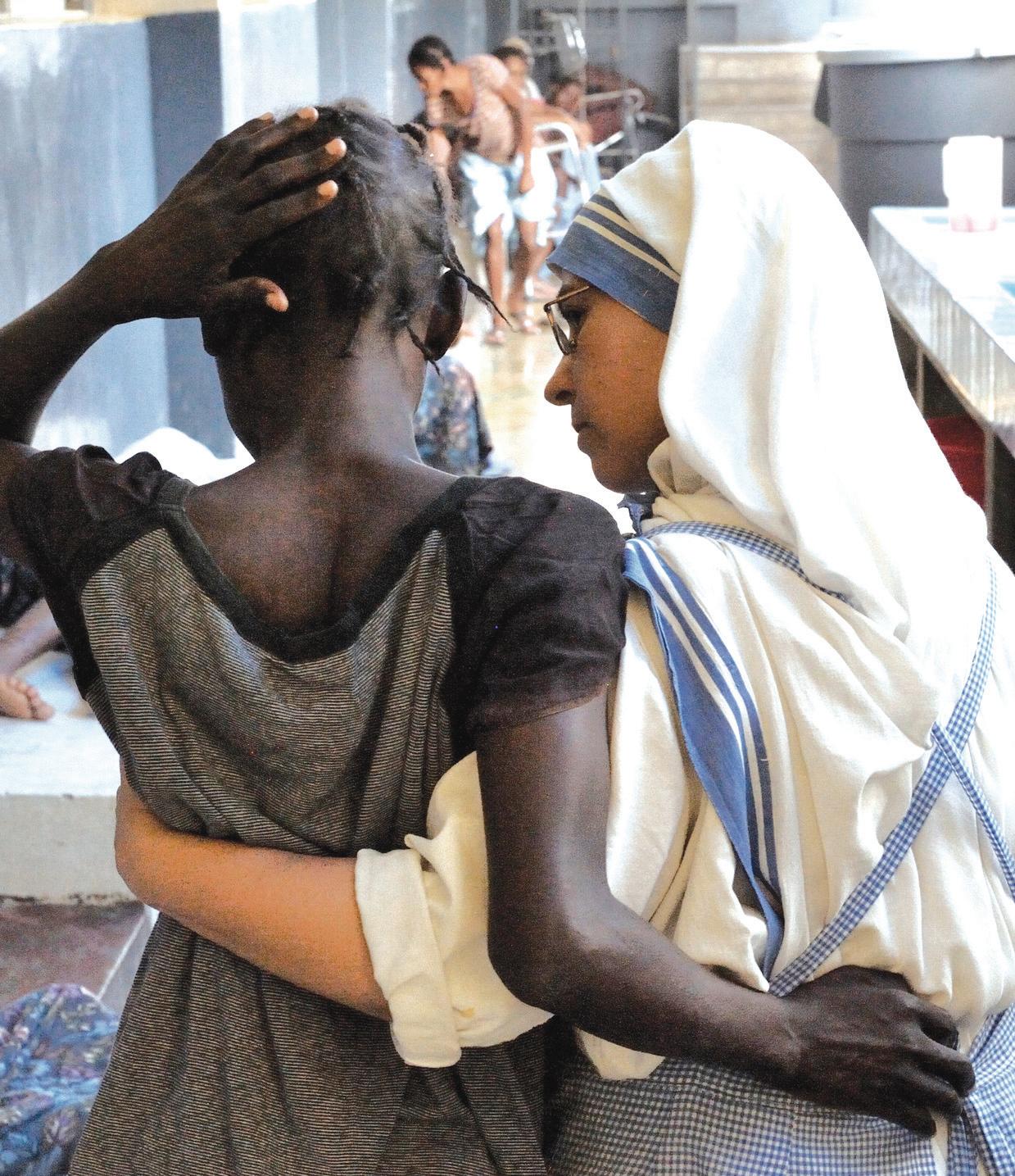
VATICAN CITY - An article in the Vatican newspaper said that, on a practical level, condom campaigns increase the possibility of AIDS infection by promoting a false sense of security.
On a moral level, the article said, condom use by married couples goes against the Church’s teaching about responsible procreation because it “deforms” the conjugal act.
The article was written by Fr Juan Perez-Soba, a moral theologian who teaches in Rome at the John Paul II Institute for Studies on Marriage and the Family. It appeared in L’Osservatore Romano on 24 May, three days before the start of a major Vatican conference that was expected to clarify church teaching on AIDS.
Fr Perez-Soba said that although use of a condom may have some effectiveness against HIV/AIDS contagion in single acts, it cannot guarantee safety - especially throughout the sexual life of a couple. It is wrong, therefore, to say that condom use can prevent infection, he said.
“The numerous campaigns that invite people to use the condom indiscriminately have instead demonstrated the contrary: By feeding the false belief that there is no danger, they have increased the possibility of infection,” he said.
“To present the condom as a solution to the problem is a grave error; to choose it simply as a habitual practice is to show a lack of responsibility in regard to the other person,” he said.
Turning to moral aspects, Fr Perez-Soba said condom use clearly

VATICAN CITY (CNS) - A Vatican Cardinal opened an international conference on AIDS by strongly defending the Church’s two-pronged strategy against the disease: education of consciences and mobilisation of Catholic health resources for patients.
violates the Church’s vision of conjugal love as presented in the 1968 encyclical Humanae Vitae
“A sexual act carried out with a condom cannot be considered a fully conjugal act” because it deprives the act of its unitive sense and procreative sense, he said.
“An act is not truly unitive when it intentionally impedes the communication of the sperm and excludes the possibility of its reception in the mutual gift of the bodies of the spouses,” he said.
Fr Perez-Soba said this was a “general ethical judgment” about condom use by married couples, “without entering into the prudential consideration about the risk of infection.”
He went on to suggest, however, that for a married couple in which one spouse is infected with HIV, sexual abstinence is the proper response.
“Faced with the insuperable possibility of infection, they can agree to adopt the decision to abstain from having sexual relations for reasons of health, as happens with other pathologies,” he said.
He said the Church teaches that a couple’s marriage promise brings with it the commitment to respond to difficult situations “with generosity.” In such difficult situations, he said, a couple needs to “find the necessary strength to live the truth of their vocation, trusting in the grace of God and seeking the accompaniment of the Church, which assists them on their path.”
The question of condom use by married couples to prevent AIDS has been quietly debated for years by Vatican officials, theologians and pastors. Some Bishops and Cardinals have argued that a married couple in which one spouse has AIDS may reasonably be expected to use condoms to prevent transmission of the deadly disease.
Others, citing Humanae Vitae, have said the Church can never approve a practice that goes against the understanding of the conjugal act in marriage as a complete form of self-giving that is open to life.
Cardinal Tarcisio Bertone, the Vatican secretary of state, told more than 100 invited experts on 27 May that the Church places human dignity at the centre of its AIDS policies, which necessarily include a solid ethical dimension.
“Educating people to avoid high-risk behaviour, when based on solid moral principles, fully demonstrates its effectiveness and translates into greater openness toward those already affected by the virus,” the Cardinal said.
“When responsibility for one’s own behavior is affirmed, in fact, there is greater awareness of the connection with the rest of the community and greater sensitivity toward those who suffer.”
Cardinal Bertone underlined the Catholic Church’s massive involvement in treating and caring for AIDS patients through its worldwide network of hospitals, clinics and dispensaries.
He said part of the Church’s effort was to help remove the “social stigma” that is still borne by those with HIV and AIDS.
The Cardinal did not mention the question of condoms in AIDS prevention. In previous days, the Vatican newspaper ran two articles saying condom campaigns were unsuccessful in stopping the AIDS epidemic; one article said condom campaigns had increased the possibility of AIDS infection by promoting a false sense of security.
Archbishop Zygmunt Zimowski, head of the Pontifical Council for Health Care Ministry, told the assembly that the conference would take up the crucial issue of access to health care by AIDS patients in poorer countries.
The conference participants included a top UN official, medical experts from various parts of the world and theologians.
VATICAN CITY - Because it acts in the name of the Catholic Church in promoting development and helping the needy, Caritas Internationalis must be guided by Bishops and the official teaching of the Church, Pope Benedict XVI said.
The Vatican is responsible for following the activities of Caritas and “exercising oversight to ensure that its humanitarian and charitable activity, and the content of its documents, are completely in accord with the Apostolic See and the Church’s Magisterium,” the Pope said on 27 May during a meeting with delegates to the Caritas general assembly.
Representatives of the 165 national Catholic charities that make up the Caritas Internationalis confederation met in Rome from 22-27 May. The general assembly’s agenda included work on new statutes that would strengthen Vatican oversight of the organisation’s operations, reflecting Pope Benedict’s teaching on Christian charity and that in 2004, Caritas Internationalis was given a special juridical status by the Vatican.
Pope Benedict said that with the new juridical status, Caritas “took on a particular role in the heart of the ecclesial community and was called to share, in collaboration with the ecclesiastical hierarchy, in the Church’s mission of making manifest, through practical charity, that love which is God Himself.”
Caritas, he said, is called to bring

Caritas Internationalis has approved Michel Roy, an official with the French charity Secours Catholique, as its new secretary general for the next four years. PHOTO: CNS/COURTESY OF ELODIE PERRIOT,
the Church’s message to international political and social discussions. However, he said, “in the political sphere - and in all those areas directly affecting the lives of the poor - the faithful, especially the laity, enjoy broad freedom of activity.
“No one can claim to speak ‘officially’ in the name of the entire lay faithful, or of all Catholics, in matters freely open to discussion,” Pope Benedict said. “On the other hand, all Catholics, and indeed all men and women, are called to act with purified consciences and generous hearts in resolutely promoting those values which I have often referred to as ‘non-negotiable,’” he said.
The Pope has used the term in reference to the obligation to protect human life and to support the traditional family based on the
life-long marriage of a man and a woman open to having children.
Honduran Cardinal Oscar Rodriguez Maradiaga of Tegucigalpa, who was re-elected president during the assembly, told Pope Benedict, “Wherever a sign of God’s love is needed, Caritas is there.”
Caritas, the Cardinal said, “is a faith-filled answer” to people’s cries for help and is an advocate for the dignity of the poor and their human rights. “We have dreamed and continue to dream of a world formed by one human family and with zero poverty,” he said.
Pope Benedict told members that because their confederation is able “in a certain way to speak and act” in the Church’s name, Caritas has “particular responsibilities in terms of the Christian life, both personal and in community. Only on the basis of a daily commitment to accept and to live fully the love of God can one promote the dignity of each and every human being.”
For Catholics, “charity is understood not merely as generic benevolence, but as self-giving” designed to help each and every person come to know the love of Christ, he said.
As a global confederation helping millions of people in dozens of countries each year, Caritas increasingly is listened to in international forums, the Pope said, and he thanked Caritas for being an advocate of “a sound anthropological vision, one nourished by Catholic teaching and committed to defending the dignity of all human life.”
Pope Benedict said that without recognising that human beings were created by God and are called to eternal life, “we risk falling prey to harmful ideologies” that do not advance the good of the whole human person because integral development includes the person’s spirituality and eventual salvation.
ROME(CNS) - Members of Caritas Internationalis elected an official from the French charity Secours Catholique to be their secretary general and they re-elected Honduran Cardinal Oscar Rodriguez Maradiaga of Tegucigalpa as president of the confederation of 165 Catholic charities.
Michel Roy, director of international advocacy for the French Catholic charity, was elected by regional representatives making up the Caritas executive committee. His election was confirmed on 26 May by delegates to the Caritas Internationalis general assembly.
A 56 year old father of two children, Roy was a student of economics and Oriental languages at Sorbonne University when he began volunteer work with Southeast Asian refugees for Secours Catholique in 1976. He joined the Paris Archdiocesan staff in 1981 and served as national director from 1993 to 1999.
Roy was elected to a fouryear term after the Vatican Secretariat of State withheld its approval for the current secretary general, Lesley-Anne Knight, to stand for a second term. Addressing the assembly immediately after the vote, Roy
said, “I’m very moved by this. I’d like to thank Lesley-Anne for the work she’s done so far and also all of you for the work that you do for this network which reflects the hopes of the poor to build a better world.”
Cardinal Rodriguez was elected on 24 May to a second fouryear term as president, winning about 75 per cent of the votes from delegates from the confederation’s member organisations, which include the US Bishops’ Catholic Relief Services and the Canadian Catholic Organisation for Development and Peace.
At the opening of the general assembly, Cardinal Rodriguez said the way the Vatican handled Knight’s case caused hurt among Caritas members.
In his formal president’s report to the assembly the morning before his re-election, the Cardinal spoke about the issue at the centre of the discussions between the Vatican and Caritas Internationalis: strengthening the Catholic identity of Catholic charitable activities, staff members and volunteers.
The Cardinal said: “Caritas is not simply a nongovernmental organisation - it is much more. Caritas is a sign of the love of God for all humanity. It is a love that knows no bounds or boundaries.”
“Caritas gives witness to God’s love among us, a love for all people and especially for the poorest. Our experience and our formation of the heart through the encounter with Christ in the stranger and the marginalised transforms Caritas in its daily work into an authentic witness of God’s love present in our world,” he said.
VATICAN CITY - When Bishop
Daniel R Jenky of Peoria, Illinois, presented Pope Benedict XVI with two thick volumes about the life of Archbishop Fulton J Sheen, the Pope surprised him by saying he had worked with the late Archbishop.
Pope Benedict “told me something I hadn’t known: he worked on the commission for mission at the Second Vatican Council with Fulton Sheen,” Bishop Jenky told CNS. The Pope served as a theological expert at the council in the 1960s. At the end of the Pope’s weekly general audience on 25 May, Bishop Jenky presented the Pope with two leather-bound volumes with golden lettering on the side: “Fultonius Ioannes Sheen.”
The tomes - totaling close to 2,000 pages - are the positio, the official position paper, outlining why the Catholic Church should recognise Archbishop Sheen as a saint.
Archbishop Sheen, who was born in Illinois in 1895 and died in New York in 1979, was an Emmywinning televangelist. His programme, Life is Worth Living, aired in the United States from 1951 to 1957. Bishop Jenky said, “I hope it helps” that the Pope personally knew Archbishop Sheen, who was national director of the Society for the Propagation of the Faith in 1950-66 and attended every ses-

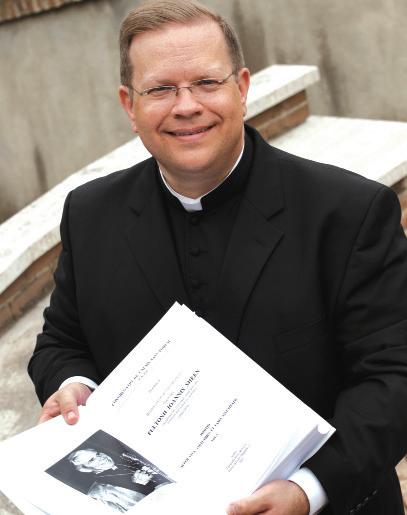
sion of Vatican II. For the Peoria Bishop, the most impressive thing about Archbishop Sheen was his untiring evangelising effort, which was addressed not just to radio or television audiences, but to taxi drivers and anyone else he happened to meet.
“I don’t know how many people he brought to the faith; it must be thousands and thousands,” the Bishop said. “He never passed by an opportunity to bring someone to the faith. He was a hands-on evangeliser.”
Mgr Stanley Deptula, executive director of the Peoriabased Archbishop Fulton Sheen
Foundation, joined Bishop Jenky for the trip to the Vatican. They also gave the Pope an album with more than 100 letters from Cardinals and Bishops in North America, Australia and Africa supporting Archbishop Sheen’s cause.
Mgr Deptula told CNS that Archbishop Sheen should be beatified and canonised because “he was a dynamic missionary, he used all the modern means available to spread the Gospel throughout the world.” In fact, the archbishop was host of The Catholic Hour radio programme for 22 years before beginning his television career, he wrote several popular books and
travelled the world speaking and preaching once his TV programme went off the air. The diocesan phase of the sainthood cause concluded in 2008 and the postulator, or promoter, of the cause took the eight boxes of eyewitness testimony and “every book Sheen ever wrote” and summarised the material, creating the positio, the Monsignor said. The Congregation for Saints’ Causes will study the “positio” and if congregation members agree, they will recommend that the Pope officially declare that the Archbishop lived
the Christian virtues in a heroic way. Before Archbishop Sheen can be beatified, the Pope also must recognise a miracle attributed to his intercession.
“We actually have two fully-documented alleged miracles of cures that seem to have been effected by God through the intercession of Archbishop Sheen,” Mgr Deptula said. “Actually, we also have a couple more that have come into our office. Really, every day I hear stories about little miracles, ways that Fulton Sheen continues to change lives today.”
The best documented cases involve cures that took place in the United States, he said. “One happened in central Illinois to an elderly woman in the Champaign area. And the other, kind of the stronger case that we will probably be pursuing to present to the Holy Father, involved a baby in the Pittsburgh, Pennsylvania, area.”
The Monsignor said he could not reveal many details about the case, but “basically this baby was born ... with several life threatening diseases, any one of which would have been a very serious illness for this infant.”
“The parents and family and friends prayed for the intercession of Archbishop Sheen. They had the baby baptised, (and) I believe his middle name is Fulton,” he said. “It seems to have been a miracle. The baby lived and seemed to have been cured of those illnesses” and is now in the first or second grade.
VATICAN CITY (CNS)Catholics, like everyone, often are challenged to balance the demands of family, work and free time, but they also have an obligation to show others there is a Christian approach to all three, said Cardinal Dionigi Tettamanzi of Milan.
“Our being Catholic should become a unique and original way of living the challenges that face every family,” the cardinal said at a 24 May Vatican news conference to discuss plans for the World Meeting of Families 2012.
The international gathering, co-sponsored by the Pontifical Council for the Family, will be held in Milan from 30 May to 3 June, 2012. Pope Benedict XVI is expected to attend.
At the Vatican news conference, Cardinal Tettamanzi and Cardinal Ennio Antonelli, president of the family council, presented catechetical material their staffs developed to help Catholic couples around the world prepare for the gathering.
The Family: Work and Celebration is the theme Pope Benedict chose for the 2012 gathering and while Cardinal Antonelli said specific challenges vary widely around the world, “globalisation means that many problems are becoming common everywhere in the world.”
The Pontifical Council for the Family has translated the catechetical material into English, Spanish, French, German, Portuguese and Polish and will send the texts to bishops’ conferences to print, distribute and adapt, he said.
The booklet, which is designed to be used at 10 periodic meetings of small groups of families, offers reflections from the Bible and from papal documents on the themes of marriage and family life, human dignity and labor, and rest, celebration and keeping Sunday as the Lord’s day.
Each chapter includes discussion questions for a husband and wife to talk about and for groups of couples to discuss together.
Fr Davide Milani, director of communications for the Archdiocese of Milan, said the group discussions as well as more global sharing through Facebook and other media would ensure that the preparation period is not focused exclusively on the experiences of families in Europe. The Archdiocese has launched a website for the 2012 meeting - www.family2012.com - and the Pontifical Council for the Family also has opened a new website - www.family.vaalthough as of 24 May most of the content was available only in Italian.
Auxiliary Bishop Franco Brambilla of Milan, who coordinated the drafting of the catechesis, said Catholic couples should be aware of just how much work and free time influence their family life, but they also must recognise that they can “transform the world through work and humanise time with a Christian sense of celebration, especially regarding Sundays.”
Can a doctor discuss faith? Or should it never be mentioned?
BY PETER SAUNDERS Analysis, CommentAChristian family doctor has been reprimanded by the UK’s General Medical Council for talking about his faith to a patient. Dr Richard Scott was accused of “harassment” and told by the medical regulator that he risked bringing the profession into disrepute by discussing his religious beliefs.
He has refused to accept a formal warning on his record, and is instead taking legal action to fight the censure with the assistance of the Christian Legal Centre and a leading human rights lawyer, Paul Diamond.
Dr Scott, who says he has shared his faith with thousands of patients in the past, saw the 24-year-old patient who is at centre of the complaint in 2010. Following the consultation, the patient’s mother complained that the doctor had abused his position by “pushing religion” on her son.
However, Dr Scott argues that he acted within official guidelines, having asked if he could talk about his Christian beliefs to the patient, who is of a different faith, and having ended the conversation as soon as he was asked to. The conversation only turned to faith issues after they had fully explored the medical options.
This is Dr Scott’s version of what happened. “The GMC said I had exploited a vulnerable patient. I say I was trying to help a needy patient,” Dr Scott told the British Medical Journal
“It’s actually one of the longest consultations I’ve had, 20 minutes, trying to establish the details of his very detailed problem. And then in the last five minutes I said to him, ‘Look, there’s something here that I’ve found over the years has been very helpful to me and many of the patients who sat in your chair. It’s about the Christian faith; you probably realise I’m a Christian doctor.’”
He asked the patient whether he could discuss this, and he had replied, “Go for it.”
“Towards the end he actually did become a little bit heated and I could see it wasn’t going anywhere, so we stopped. I finally said, ‘I will do the things obviously your mother has rung up about in the first place, the standard medical stuff, we’ll do that.’ In her complaint against me she said that I’d been highly unprofessional and not done anything medical at all in the conversation, which is totally wrong and can be proved on the computer.”
After receiving the complaint, the GMC apparently sent Dr Scott a letter warning him over his conduct and told him that the way he expressed his religious beliefs had “distressed” the patient and did “not meet with the standards required of a doctor”.
Dr Scott, a doctor for 28 years, works at the Bethesda Medical Centre in Margate, Kent. Its six partners are all Christians and state on the government’s NHS Choices website that they are likely to discuss spiritual matters with patients during consultations.
Niall Dickson, chief executive of the GMC, is reported by the Telegraph as saying:
“Our guidance, which all doctors must follow, is clear. Doctors

should not normally discuss their personal beliefs with patients unless those beliefs are directly relevant to the patient’s care. They also must not impose their beliefs on patients, or cause distress by the inappropriate or insensitive expression of religious, political or other beliefs or views.”
However Dickson has been quite selective in his quotation of the guidance which actually gives doctors a lot of freedom in expressing their faith, provided they do it in an appropriate and sensitive way. The GMC guidance in question, Personal beliefs and medical practice, was published on March 17, 2008. The Christian Medical Fellowship contributed to the consultation leading to its publication and published a review of the guidance at the time. At the time of the publication of the guidance Dr John Jenkins, Chair of the GMC Standards and Ethics Committee said:
“The GMC recognises that personal beliefs, values, and cultural and religious practises are central to the lives of doctors and patients. The guidance balances a doctors’ right to practise in accordance with their views and beliefs, and patients’ right to receive timely and appropriate medical care.”
The guidance states specifically that it “attempts to balance doctors’ and patients’ rights - including the right to freedom of thought, conscience and religion, and the entitlement to care and treatment to meet clinical needs - and advises on what to do when those rights conflict.” It is not intended to “impose unnecessary restrictions on doctors” but does point out that doctors have an obligation not to impose their beliefs on patients:
“You must not express to your patients your personal beliefs, including political, religious or moral beliefs, in ways that exploit
of
their vulnerability or that are likely to cause them distress.”
So there is no blanket prohibition on expressing personal beliefs, as long as it is done in a way that is sensitive and appropriate. The guidance also underlines the principle that doctors must “make the care of (their) patient (their) first concern” and must treat them “with respect, whatever their life choices and beliefs”.
These are all good principles that I personally have no problem with. No doctor, Christian or otherwise, should impose his views on his patient or seek to exploit his or her position. However, the guidance goes on to stress that all patients and doctors have personal beliefs implying that these principles apply not just to those who subscribe to a particular faith, but to everyone.
“Personal beliefs and values, and cultural and religious practices are central to the lives of doctors and patients … All doctors have personal beliefs which affect their dayto-day practice.”
It also emphasises that taking account of patients’ beliefs is part of good medical care.
“Patients’ personal beliefs may be fundamental to their sense of well-being and could help them to cope with pain or other negative aspects of illness or treatment … For some patients, acknowledging their beliefs or religious practices may be an important aspect of a holistic approach to their care. Discussing personal beliefs may, when approached sensitively, help you to work in partnership with patients to address their particular treatment needs.”
I recently blogged about a new report from CMF, which has had wide international news coverage which reviews the positive health benefits of Christian faith. Good doctors do not treat their patients solely as biological or biochemi-
Mass in St Mary’s Cathedral, Victoria Square.
The Philippines proclaimed its political independence from the Spanish colonial rule113 years ago after a very difficult struggle - the first nation to declare
cal machines. Rather they practise “whole person” medicine that is not concerned solely with physical needs, but also addresses social, psychological, behavioural and spiritual factors that may be contributing to a person’s illness.
Here we have the case of a doctor who has talked to many patients about faith matters and who has had only a very small handful of complaints. He seems genuinely to make his patients’ welfare his main concern, and when he feels it appropriate to raise spiritual issues does so with sensitivity and respect. From the facts of the case, as reported, it appears that the General Medical Council has acted with inappropriate and disproportionate force and appears to have applied its (very reasonable guidance) in a selective and unbalanced way.
The London Telegraph commented in its perceptive editorial, “Doctors can be Christians too”, that “this case of a doctor reprimanded for discussing his religion is a worrying one” and accuses the GMC of an “excessive reaction”. It concludes that “we appear to be heading towards an alarming situation in which the profession of faith becomes an active disqualification”.
Let’s hope that the GMC reassesses its position and applies its own guidance in an even-handed way by balancing more carefully what it calls “the right to freedom of thought, conscience and religion” with “the entitlement to care and treatment to meet clinical needs”. If it fails to do so it may find itself losing more than its credibility.
Dr Peter Saunders is a former general surgeon and CEO of Christian Medical Fellowship, a UK-based organisation with 4,500 UK doctors and 1,000 medical students as members.
such independence in Asia. Many Filipinos today in Australia have an added reason to celebrate their own personal and family freedom from any number of difficult situations they might have had in the Philippines.
 with Debbie Warrier
Ingrid Geldart
with Debbie Warrier
Ingrid Geldart
Igrew up in South Africa. I think that South Africans generally believe that there is a God. I was baptised Catholic and my sister was baptised Methodist to keep our respective Catholic and Methodist grannies happy.
When I was 13 I joined a kid’s club at a Baptist Church. I met my husband Justin at Church and we went together to New Zealand when I was 18. We were there for seven and a half years. We went from Baptist, to Reformed Baptist, to Presbyterian, to Anglican.
Justin began researching Catholicism and often discussed it with me. I would generally “agree” with him, but said “I am not going to become Catholic”. Eventually I agreed to start the RCIA process with Justin. After attending some of the classes I started to see that Catholicism wasn’t so bad.
When I realised that Justin was set on becoming Catholic, I thought that I couldn’t have a family where there were two different faiths held by two different parents. We have three children Elizabeth, 3,Danielle, 2 and Sean, 5 months, and that would make them horribly confused.
It forced me to make a choice. I decided that I trusted Justin and believed he knew what he was doing. We knew that there were people that didn’t support our decision to be Catholic. They weren’t mean about it. We knew that they didn’t agree, but they also respected our decision.
Justin’s side of the family is Seventh Day Adventist, which generally speaking tends to be against Catholicism. We were quite worried that Justin’s granny might be upset about our decision – but she was wonderfully supportive of us, which was a real blessing. Fr Sam Pulanco told us, “When you go to heaven, God isn’t going to ask you what your granny believed, or what your mother believed or what your dad believed. He is going to ask you what you believed.” That settled it for me because I realised that it ultimately doesn’t really matter what everyone else thinks.
We moved to Perth in February this year. We completed the RCIA process we had begun in New Zealand and were formally accepted into the Catholic Church. As the structure of the RCIA process is different here I am going through it again to catch up on what I missed. It is my main source of information about Catholicism and I have got a lot out of it.
Catholicism was nothing like what I thought it would be. I originally thought that Catholics were misled idolaters and Maryworshippers.
More recently, I have grown fond of praying the rosary. I relate to Mary as a woman, wife and mother. I learn from her and appreciate her humanness. It makes her more approachable. I especially ask her to pray that I might have patience being a mother of three pre-schoolers.

I found my first confession very special though stressful. I realised that it is necessary. Prior to becoming Catholic I thought reconciliation was unnecessary and just the priest wanting to know your secrets.
Finally, I discovered that Catholics were in fact normal, genuine people. The Catholic Church just accepts you the way you are. You can be human and still be Catholic. My faith is who I am and what I do. It’s my life.
Justin GeldartIgrew up in South Africa. As a child I attended the Seventh Day Adventist Church with my grandmother. When my parents got divorced, I moved in with my dad and step-mum. We ended up in a Baptist Church, where I met my wife Ingrid.
After I left school, I went off the rails and got excommunicated from our Baptist Church. God brought me back and I started studying theology seriously. Sadly, I regressed and was excommunicated again.
In 2002, Ingrid and I moved to New Zealand. We attended a Baptist Church, initially to keep up appearances – but it drew us back into our faith. Following our wedding, we underwent substantial theological shifts as I delved more into theology – these shifts led us to change from Baptist, to Reformed Baptist, to Presbyterian, to Anglican.
Prior to converting, I thought Catholics were idolaters worshipping bread, and praying to Mary. A friend explained that Catholics don’t worship bread, but Jesus who is present in the consecrated Host and they don’t pray to Mary, but ask her for her prayers. I finally admitted that I could call Catholics “Christians”, but I was adamant that I’d never become one.
Around this time I took a job near a Catholic Cathedral. Passing by I thought, “These poor people are so deceived - if only they could know Christ”. One day I decided to have a look inside. I was struck by

 By Fr John Flader
By Fr John Flader
the reverence of the place. It was like stepping onto holy ground. I even took Ingrid there saying “You have to see this. The reason Catholics are so blinded by their religion is because it’s so beautiful.”
Previously I had thought Catholics were simple, superstitious people. I couldn’t understand why anyone studying the Scriptures would want to be Catholic. I decided to attend Mass at the Cathedral and was astounded by how Scriptural it was, and the people attending were ordinary people like me. I had been so indoctrinated against Catholicism I almost believed Catholics were a different breed.
I started going to the Cathedral more often for Mass and prayer. By chance, I also stumbled across a newspaper advertisement for the Catholic Enquiry Centre, so I applied for their booklets on the basics of Catholicism. When the booklets arrived, I was surprised by how solidly Biblical the theology was.
At the same time, the Anglican Archbishop of Canterbury was trying to deal with the homosexual ordination issue.
I started to appreciate the validity of having a figure like the Pope to guide the Church on issues of faith and morality. Surprisingly, I also started to find the Catholic Church fitting my search for a Church with the authority of the Apostles.
The Catholic doctrine of Apostolic Succession asserts that properly ordained bishops are the chosen successors of the Twelve Apostles, who have therefore inherited the spiritual, ecclesiastical, and sacramental authority that Christ originally gave the Apostles.
By the time I joined RCIA, I was already Catholic in my heart. Ingrid and I completed the RCIA process in Australia where we moved with our children in February this year.
My faith has always been real to me – even when I fell away I never really stopped believing in God. Being Catholic gives me hope. The Catholic Church is where I found Christ in His fullness.
Q: I know that the Church forbids the use of contraception in marriage, but if a couple are trying to avoid having a child, what is the difference between using contraception and using natural family planning?
First of all, it is important to be aware that there can be justifiable reasons for avoiding having another child, whether for the time being or even permanently.
Pope Paul VI said this in his encyclical Humanae Vitae (1968): “In relation to physical, economic, psychological and social conditions, responsible parenthood is exercised, either by the deliberate and generous decision to raise a numerous family, or by the decision, made for grave motives and with due respect for the moral law, to avoid for the time being, or even for an indetermined period a new birth” (n. 10).
That is, conditions such as the grave physical or psychological illness of either spouse, great economic hardship, etc., can justify spacing out births or even avoiding having another child altogether.
Returning to your question, if a couple have a sufficient reason to avoid having another child, what difference does it make whether they use natural family planning or contraception? It makes a great difference.
God’s plan in giving human beings the sexual power was that this power be used as an intimate expression of love in marriage – the unitive aspect –always open to the transmission of life – the procreative aspect.
In Humanae Vitae Pope Paul explained that the reason why contraception is always immoral is “the inseparable connection, willed by God and unable to be broken by man on his own initiative, between the two meanings of the conjugal act: the unitive meaning and the procreative meaning… By safeguarding both these essential aspects, the unitive and the procreative, the conjugal act preserves in its full-
ness the sense of true mutual love and its ordination towards man’s most high calling to parenthood” (n. 12).
When spouses practise natural family planning, they choose to have marital relations only during the infertile periods of the woman’s cycle. They do not close off their fertility and capacity to bring forth new life, but simply observe a cycle created by God himself.
They are always free to engage in sexual relations or not, so if they choose not to engage in these relations for some days each month, they do nothing immoral.
Moreover, their marital relations are acts of true love, of total, mutual self-giving. The couple reflect God’s total selfgiving to man by giving themselves completely to each other, including their fertility, holding nothing back. Implied in their choice is the loving acceptance of any child God may send them.
In using contraception, on the contrary, the couple do not give themselves totally to one another. They give their bodies but withhold their fertility by using a physical or chemical barrier to avoid offspring, thus altering the very nature of the act. Not only is this contrary to God’s plan for the use of sexuality, it is not true love.
Pope John Paul II explains in his Apostolic Exhortation Familiaris Consortio (1981) that “the innate language that expresses the total reciprocal self-giving of husband and wife is overlaid, through contraception, by an objectively contradictory language, namely, that of not giving oneself totally to the other. This leads not only to a positive refusal to be open to life but also to a falsification of the inner truth of conjugal love, which is called upon to give itself in personal totality” (n. 32).
An act of marital union using contraception is an act of sex, but not of love. Couples who have been using contraception and later give themselves completely to one another without any barriers appreciate the difference keenly.
Moreover, couples who practise natural family planning for good reasons often find that their love for each other actually grows. In abstaining from marital acts for some days each month by mutual agreement, they grow in respect for each other and in self-mastery.
THURSDAY, 2 JUNE
Contributions may be emailed to office@therecord.com.au, faxed to 9325 4580, or mailed to PO Box 3075, Adelaide Terrace, Perth WA 6832.
The Greatest Silence movie screening
7.15pm at Our Lady of the Most Blessed Sacrament parish hall, 175 Corfield St, Gosnells (off Isdell Pl). Hosted by Caritas Australia and our parish. Powerful documentary by Emmy Award-winning filmmaker Lisa Jackson. Be a voice for women in the Congo, get informed and take action. 16 years and above. Donation. Refreshments provided. RSVP by 31 May. Enq: Maureen secretary@ gosnellsparish.org.au or 9398 2331.
FRIDAY, 3 JUNE
Pro-life witness
9.30am at St Brigid’s Parish, Midland. Mass followed by Rosary procession and prayer vigil at nearby abortion clinic led by the Franciscan Friars of the Immaculate. Come and pray for an end to abortion and the conversion of hearts. Enq Helen 9402 0349.
FRIDAY, 3 TO SUNDAY, 5 JUNE
‘Be Inflamed’ Weekend Retreat for Teens
6pm at Eagle’s Nest Retreat Centre, 1406 O’Brien Rd, Gidgegannup. Teens aged 13-17. Weekend of fun, activities, music and spiritual talks from fantastic speakers. Cost $60. Concludes Sunday 1.30pm. Download registrations at cym.com.au. Enq: Stefania 9422 7914 or admin@cym.com.au.
FRIDAY, 3 TO SATURDAY, 11 JUNE
Novena to the Holy Spirit
7.30-8.30pm at Holy Family Parish, Lot 375 Alcock St, Maddington. 7.30-9.30pm Fridays. Includes Holy Hour, Holy Spirit formation and prayers. Concludes Saturday with a Solemn Night Vigil, Midnight Eucharistic Adoration, healing, anointing prayer and Holy Mass. Enq: Fr Varghese 9493 1703.
SATURDAY, 4 JUNE
Vigil for life
8.30am at St Augustine’s Parish, Gladstone St, Rivervale. Mass followed by Rosary procession and vigil at abortion clinic led by Fr Paul Carey SSC. Weekly prayer vigils: Monday, Thursday and Saturday 8.30-10.30am. Come and pray for the conversion of hearts and an end to abortion. Enq. Helen 9402 0349.
Day with Mary
9am-5pm at St Brigid’s Church, 69B Morrison Rd, Midland. Day of prayer and instruction based on the Fatima message. 9am Video; 10.10am Holy Mass; Reconciliation, Procession of the Blessed Sacrament, Eucharistic Adoration, Sermons on Eucharist and Our Lady, Rosaries and Stations of the Cross. BYO lunch. Enq: Franciscan Sisters of the Immaculate 9250 8286.
SUNDAY, 5 JUNE
Divine Mercy
1.30pm at St Francis Xavier Parish, 25 Windsor St, Perth. Main celebrant: Fr Dough Harris. Homily on ‘Adoration of Jesus in the Blessed Sacrament’, followed by Rosary, Chaplet of Divine Mercy and Benediction. Refreshments afterwards. Enq: John 9457 7771.
SATURDAY, 11 JUNE
Divine Mercy
2.30pm at St Francis Xavier Parish, 25 Windsor St, East Perth. Main celebrant: Fr Marcellinus. Reconciliation in English and Italian. Divine Mercy prayers followed by Veneration of First Class Relic of St Faustina Kowalaska. Refreshments. Enq: John 9457 7771.
St Padre Pio Day of Prayer
8.30am at All Saints Chapel, Allendale Sq, Perth. Begins with St Pio DVD; 10am exposition of Blessed Sacrament, Rosary, Divine Mercy, Adoration and Benediction. 11am Mass with Confession. 12pm lunch. Bring plate to share. Enq: Des 6278 1540
SUNDAY, 12 JUNE
City Beach Parish 50th Anniversary
9am at Holy Spirit Parish, 2 Keaney Pl, City Beach. Mass celebrated by Archbishop Hickey, followed by brunch in the parish hall. Holy Spirit Parish has touched many lives so please come celebrate with us. Enq and RSPV: Fr Kettle 9341 3079 or email holyspirit.parish@perthcatholic.org.au
SATURDAY, 18 JUNE
25th Jubilee Parish Dinner Dance
7pm at St Simon Peter Parish, 20 Prendiville Ave, Ocean Reef in the Prendiville gym. Fabulous evening of music, dancing and a 3-course meal. Tickets $35 per person and Seniors $30. BYO alcohol and soft drinks. Coffee and tea provided. Tickets on sale now after all Masses and from Parish Office. Enq: Monique 9300 4885.
SUNDAY, 19 JUNE
Taize Prayer Service
7pm at Sisters of St Joseph Chapel, 16 York St, South Perth. Come be still and pray in the silence of a candlelit chapel. Please bring a torch. Enq: Sr Maree 0414 683 926.
MONDAY, 20 AND TUESDAY, 21 JUNE
Healing Ministry
10am at The Good Shepherd Parish, Cr of Morley Dr and Altone Rd. Fr Michael Truong Luan Nguyen will minister the Healing Ministry in two full day programmes. Begins with healing Mass; 3pm Divine Mercy Devotions; 7pm Healing Service. Individual apps available during day. Enq: office 9279 8119.
PILGRIMAGE TO PRAGUE, POLAND AND AUSTRIA
St Jude’s Parish, Langford is organising a 13-day pilgrimage departing 1 October. It will include visits to the Shrines of Divine Mercy, Infant Jesus, the Black Madonna, St Faustina, the birthplace of Pope John Paul II and the Museum at Auschwitz. Total cost per person $5,800. Spiritual Director, Fr Terry Raj. Enq: Co-ordinator John Murphy 9457 7771, Matt 6460 6877, mattpicc1@ gmail.com.
WEDNESDAY, 5 OCTOBER TO THURSDAY, 20
OCTOBER
Pilgrimage to Rome, Lanciano, San Giovanni Rotondo and Medjugorje. Bed and breakfast, evening meals, transfers, guide, flying Emirates $3,990. Enq: 9402 2480.
FRIDAY, 11 TO TUESDAY, 22 NOVEMBER
Pilgrim Tour To The Holy Land Jordan, Israel and Egypt. Spiritual Director: Fr Sebastian Kalapurackal VC from St Aloysius Church, Shenton Park. Enq: Francis – Coordinator, 9459 3873 or 0404 893 877 or Skype ID: perthfamily.
EVERY SUNDAY
Gate of Heaven Catholic Radio
Join the Franciscans of the Immaculate from 7.30-9pm on Radio Fremantle 107.9FM for Catholic radio broadcast of EWTN and our own live shows. Enq: radio@ausmaria. com.
Pilgrim Mass - Shrine of the Virgin of the Revelation 2pm at Shrine, 36 Chittering Rd, Bullsbrook. Commencing with Rosary followed by Benediction. Reconciliation is available before every celebration. Anointing of the Sick administered during Mass every second Sunday of the month. Pilgrimage in honour of the Virgin of the Revelation, last Sunday of the month. Side entrance to the church and shrine open daily between 9am-5pm. Enq Sacri 9447 3292.
EVERY FIRST SUNDAY
Divine Mercy Chaplet and Healing Prayer 3pm at Santa Clara Church, 72 Palmerston St, Bentley.
Includes Adoration and individual prayer for healing. Spiritual leader: Fr Francisco. All welcome. Enq: Fr Francisco 9458 2944.
EVERY SECOND SUNDAY
Healing Hour for the Sick
6pm at St Lawrence Parish, 392 Albert St, Balcatta. Begins with Mass, Exposition of the Blessed Sacrament and prayers. Enq: Fr Irek 9344 7066 or ww.stlawrence. org.au.
EVERY THIRD SUNDAY OF THE MONTH
Oblates of St Benedict
2pm at St Joseph’s Convent, York St, South Perth. Oblates are affiliated with the Benedictine Abbey of New Norcia. All welcome to study the rule of St Benedict and its relevance to the everyday life of today for lay people. Vespers and tea later. Enq: Secretary 9457 5758.
EVERY FOURTH SUNDAY OF THE MONTH
Holy Hour for Vocations to the Priesthood, Religious Life
2-3pm at Infant Jesus Parish, Wellington St, Morley. The hour includes Exposition of the Blessed Eucharist, silent prayer, Scripture and prayers of intercession. Come and pray that those discerning vocations to the priesthood or Religious life hear clearly God’s loving call to them.
EVERY MONDAY
Evening Adoration and Mass
7pm at St Thomas Parish, Claremont, cnr Melville St and College Rd. Begins with Adoration, Reconciliation, Evening Prayer and Benediction. Followed by Mass and Night Prayer at 8pm. Enq: Kim 9384 0598, claremont@ perthcatholic.org.au.
EVERY TUESDAY
Novena and Benediction to Our Lady of the Miraculous Medal
6pm at the Pater Noster Church, Marmion and Evershed Sts, Myaree. Mass at 5.30pm. Enq: John 0408 952 194.
Bible Teaching with a difference
7.30pm at St Joachim’s Parish Hall, Shepparton Rd, Victoria Park. Exciting revelations with meaningful applications that will change your life. Novena to God the Father, followed by refreshments. Bring Bible, a notebook and a friend. Enq: Jan 9284 1662.
EVERY WEDNESDAY
Holy Spirit of Freedom Community
7.30pm at The Church of Christ, 111 Stirling St, Perth. We are delighted to welcome everyone to attend our Holy Spirit of Freedom Praise Meeting. Enq: 0423 907 869 or hsofperth@gmail.com.
Holy Hour at Catholic Youth Ministry
6pm at 40A Mary St, Highgate, Catholic Pastoral Centre. 5.30pm Mass followed by $5 fellowship supper. Enq: Stefania 9422 7912 or www.cym.com.au.
EVERY FIRST WEDNESDAY
Holy Hour prayer for Priests
7-8pm at Holy Spirit Parish, 2 Keaney Pl, City Beach. All welcome. Enq: Linda 9341 3079.
SECOND WEDNESDAY OF THE MONTH
Chaplets of the Divine Mercy
7.30pm at St Thomas More Catholic Church, Dean Rd Bateman. A beautiful sung devotion accompanied by Exposition and followed by Benediction. Next devotion: Wednesday 8 June. Enq: George 9310 9493 or 9325 2010(w).
EVERY THURSDAY
Divine Mercy
11am at Sts John and Paul Church, Pinetree Gully Rd,
Willetton. Pray the Rosary and Chaplet of Divine Mercy, and for the consecrated life, especially here in John Paul Parish. Conclude with veneration of the First Class Relic of St Faustina. Please do come and join us in prayer. Enq: John 9457 7771.
Fr Corapi’s Catechism of the Catholic Church
7.30pm at St Joseph Church, 20 Hamilton St, Bassendean - parish library. Enq: Catherine 9329 2691.
FIRST THURSDAY OF THE MONTH
Taize Prayer and Meditation
7.30-8.30pm at Our Lady of Grace Church, 3 Kitchener St, North Beach. Prayer and meditation using songs from the Taize phenomenon. In peace and candlelight, we make our pilgrimage. All are invited. Enq: Joan 9448 4457 or Office 9448 4888.
EVERY SECOND THURSDAY
St Denis Discussion Group
7.30pm at parishioners’ homes to discuss any aspect of our faith followed by supper and fellowship. Enq: George 9349 2187 or Anna 9242 2788, (w) 9249 2788.
FIRST FRIDAY OF THE MONTH
Holy Hour for Vocations to the Priesthood and Religious Life
7pm at Little Sisters of the Poor Chapel, 2 Rawlins St, Glendalough. Mass, followed by Adoration with Fr Doug Harris. All welcome. Refreshments provided.
Catholic Faith Renewal Evening
7.30pm at Sts John and Paul’s Parish, Pinetree Gully Rd, Willetton. Songs of Praise, sharing by a priest followed by Thanksgiving Mass and light refreshments after Mass. All welcome to attend and bring your family and friends. Enq: Kathy 9295 0913, Ann: 0412 166 164 or catholicfaithrenewal@gmail.com.
Communion of Reparation All Night Vigils
7pm-1.30am at Corpus Christi Church, Lochee St, Mosman Park. Enq: Vicky 0400 282 357 and at St Gerard Majella Church, Ravenswood Dr and Majella Rd, Mirrabooka. Enq: Fr Giosue 9349 2315, John or Joy 9344 2609. The Vigils consist of two Masses, Adoration, Benediction, Prayers and Confession in reparation for the outrages committed against the United Hearts of Jesus and Mary. All welcome.
Healing and Anointing Mass
8.45am at Pater Noster, Myaree. Reconciliation, followed by Mass including Anointing of the Sick, Praise and Worship to St Peregrine and the Sacred Heart of Jesus. All welcome. Enq: Joy 9337 7189.
Healing Mass
7pm at St Peter’s Parish, Wood Street, Inglewood. Reconciliation, praise and worship, Eucharistic Adoration, Benediction, Anointing of the Sick, special blessings and fellowship after the Mass. Celebrants, Fr Dat (parish priest) and specially invited priests. All welcome. Enq: Priscilla 0433 45 7352, Catherine 0433 92 3083 and Mary-Ann 0409 67 2304.
EVERY FIRST SATURDAY
Healing Mass
12.35pm at St Thomas Parish, cnr Melville St and College Rd, Claremont. Spiritual leader: Fr Waddell. Enq: Kim 9384 0598, claremont@perthcatholic.org.au.
ACROSS

11
1 St. ___ de Porres
5 ___ of Prague
3
4

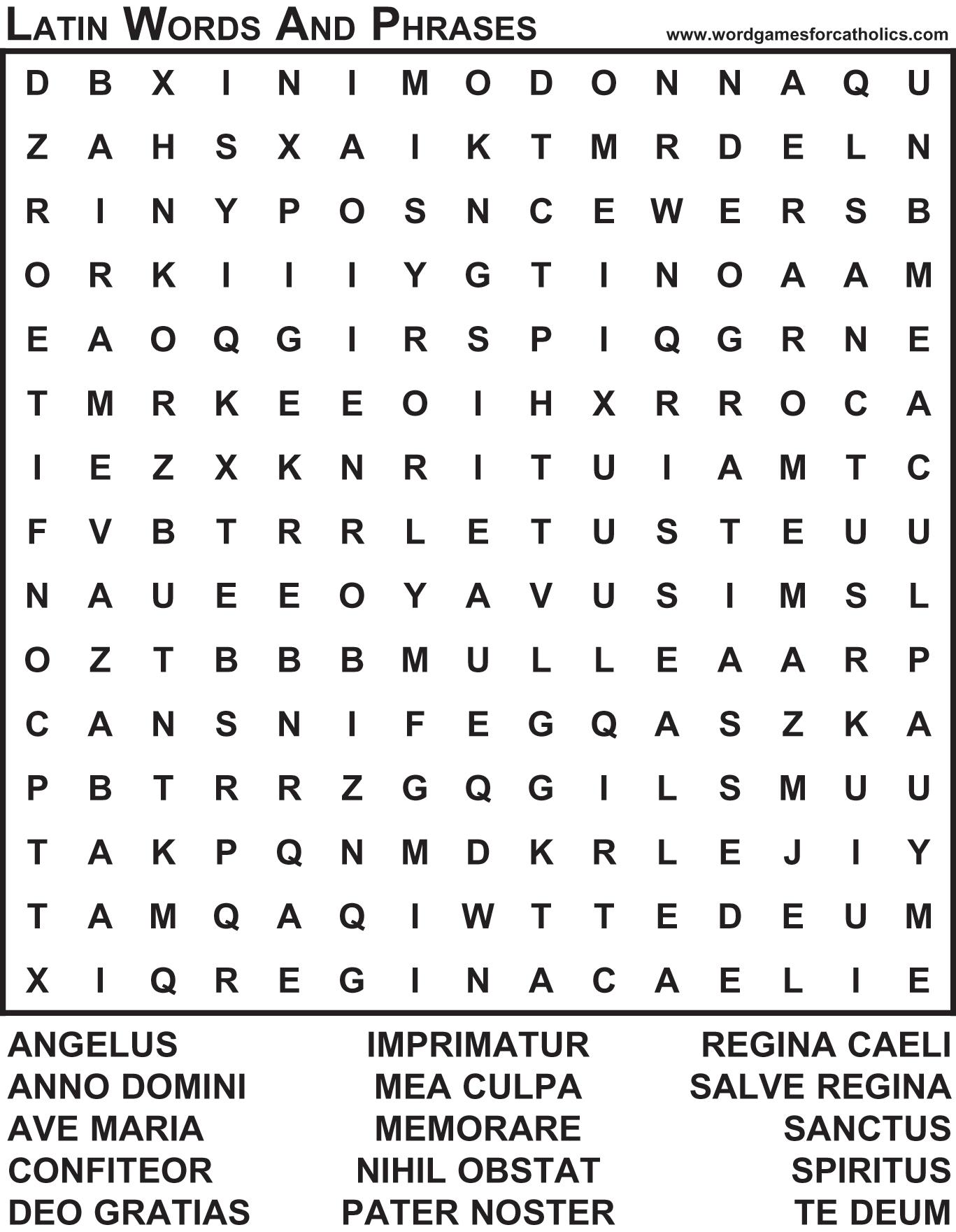
WRR LAWN MOWING & WEED
SPRAYING Garden clean ups and rubbish removal. Get rid of bindii, jojo and other unsightly weeds. Based in Tuart Hill. Enq 9443 9243 or 0402 326 637.
BUSINESS OPPORTUNITY
Work from Home - P/T or F/T, 02 8230 0290 or visit www.dreamlife1.com.
REAL ESTATE
REAL ESTATE FOR SALE
Completely fully furnished. 3 bedrooms 1 bathroom villa. Close to good Shepherd Church, Lockridge. Phone (08) 9378 4384. Price Market value.
ARE YOU BUYING OR SELLING real estate or a business? Why not ask Excel Settlements for a quote for your settlement. We offer reasonable fees, excellent service and no hidden costs. Ring Excel on 9481 4499 for a quote. Check our web site on www.excelsettlements.com.au.
MOTOR HOME FOR SALE
2003 Mercedes Sprinter, 306 CDi. Low kilometres, vg condition. Many extras. Ready to go. Bargain at $51,900. Ph 9653 1794.
FOR SALE CHEAP; VARIOUS Catholic/Protestant Books
New/2nd Hand 94404358

Deadline: 11am Monday
HOLIDAY ACCOMMODATION
ESPERANCE 3 bedroom house f/furnished Ph 09 9076 5083.
PRACTISING CATHOLIC SINGLE FATHER requires 2 bed. apartment in City. Call Bradley 0430 653 857.
MATURE AGE GENTLEMAN, SINGLE, non-smoker, and works fulltime at Royal Perth Hospital. Has been a house friend for two elderly people over the past 20 years, carrying out light houseduties and gardening when required. If you can help, please call Greg O’Brien on mob 0413 701 489.
FURNITURE REMOVAL
ALL AREAS. Competitive Rates. Mike Murphy Ph 0416 226 434.
BRENDAN HANDYMAN SERVICES Home, building maintenance, repairs and renovations. NOR. Ph 0427 539 588.
PROPERTY MAINTENANCE. Your handyperson. No job too small. SOR. Jim 0413 309 821.
BRICK RE-POINTING Ph Nigel 9242 2952.
PERROTT PAINTING Pty Ltd
For all your residential, commercial painting requirements. Ph Tom Perrott 9444 1200.
PICASSO PAINTING Top service. Ph 0419 915 836, fax 9345 0505.
NEW BOOK BINDING, General Book Repairs; Rebinding; New Ribbons; Old Leather Bindings
Restored.Tydewi Bindery 0422 968 572.
CATHOLICS CORNER Retailer of Catholic products specialising in gifts, cards and apparel for Baptism, Communion and Confirmation. Ph 9456 1777. Shop 12, 64-66 Bannister Rd, Canning Vale. Open Mon-Sat.
RICH HARVEST YOUR CHRISTIAN SHOP Looking for Bibles, CDs, books, cards, gifts, statues, Baptism/Communion apparel, religious vestments, etc? Visit us at 39 Hulme Ct (off McCoy St), Myaree, Ph 9329 9889 (after 10.30am Mon to Sat). We are here to serve.
KINLAR VESTMENTS
Quality hand-made and decorated vestments: Albs, Stoles, Chasubles, Altar linen, banners, etc. 12 Favenc Way, Padbury. By appointment only. Ph Vickii on 9402 1318, 0409 114 093 or kinlar.vestments@gmail.com.
OTTIMO Convenient location for Bibles, books, cards CD/DVDs, candles, medals, statues and gifts at Shop 41, Station St Market, Subiaco. Fri-Sun, 9-5pm.
RELATIONSHIP EDUCATION COURSE
‘Healing hurts we don’t deserve’ - a therapeutic course for those wanting to resolve issues from their past. Begins Monday, 30 May from 5-7pm, Fremantleongoing for six weeks. For details, contact Paul on 0402 222 578 or www.educationalcounselling.asn.au.
5 S THE ASCENSION OF THE LORD (Solemnity)
Wh Acts 1:1-11 Continued to appear Ps 46:2-3, 6-9 Clap your hands Eph 1:17-23 Spirit of Wisdom Mt 28:16-20 I am with you
6 M St Norbert, bishop (O)
Wh Acts 19:1-8 Paul in Ephesus
Ps 67:2-7 Wicked shall perish Jn 16:29-33 Do you believe at last?
7 Tu Acts 20:17-27 Paul’s way of life
Wh Ps 67:10-11, 2-0-21 A God who saves Jn 17:1-11 The hour has come
8 W Acts 20:28-38 Travesty of the truth
Wh Ps 67:29-30, 33-36 Blessed be God! Jn 17:11-19 World hated them
9 Th St Ephrem, deacon, doctor of Church (O)
Wh Acts 22:30, 23:6-11 Paul arrested
Ps 15:1-2, 5, 7-11 I shall stand firm Jn 17:20-26 May the all be one
10 F Acts 25:13-21 Paul in custody
Wh Ps 102:1-2, 11-12, 19-20 Give God thanks Jn 21:15-19 You know I love you
11 S St Barnabas, apostle (M)
Red Acts 11:21-26; 13:1-3 He was a good man
Ps 97:1-6 Sing Psalms
Mt 10:7-13 Give without charge






Jennifer Ferrara
Patricia Sodano Ireland
RRP $31
There are Catholics and non-Catholics alike who take it as truth that the Catholic Church is no place for a self-respecting, intelligent woman. Authors Jennifer Ferrara and Patricia Sodano Ireland disagree. Both were ordained Lutheran ministers. Both became Roman Catholics. Women in Search of the Truth tells their stories and the stories of more than a dozen other educated, articulate, accomplished women who found fulfilment in the Church.
The New Revised Standard Version
RRP $34
The only children’s New Revised Standard Version on the market, this inviting Bible is packed with thoughtfully designed features— at an amazingly reasonable price. The clear modern translation appears in readable type on sturdy Bible paper, with 24 realistic watercolor illustrations tipped in throughout. Eight pages of helps—maps and charts—are arranged at the back. Available in an appealing printed hardcover or a selection of popular colors in imitation leather.
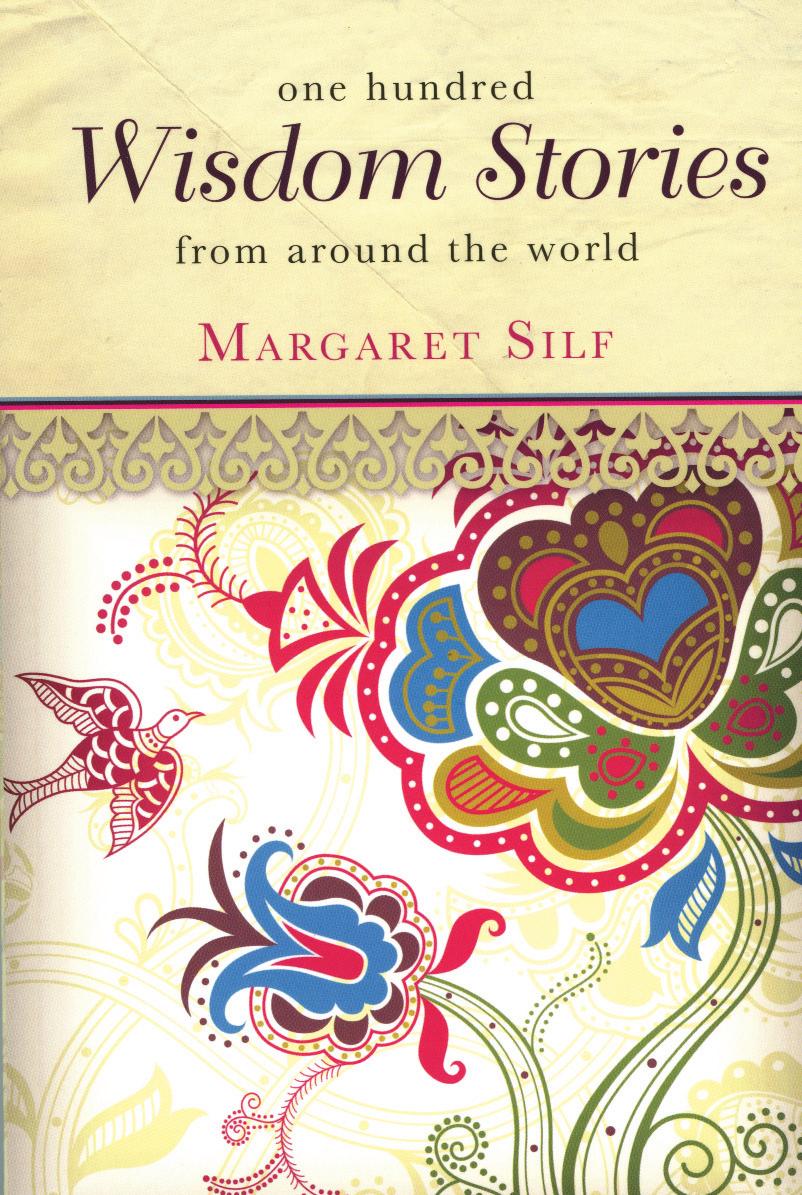

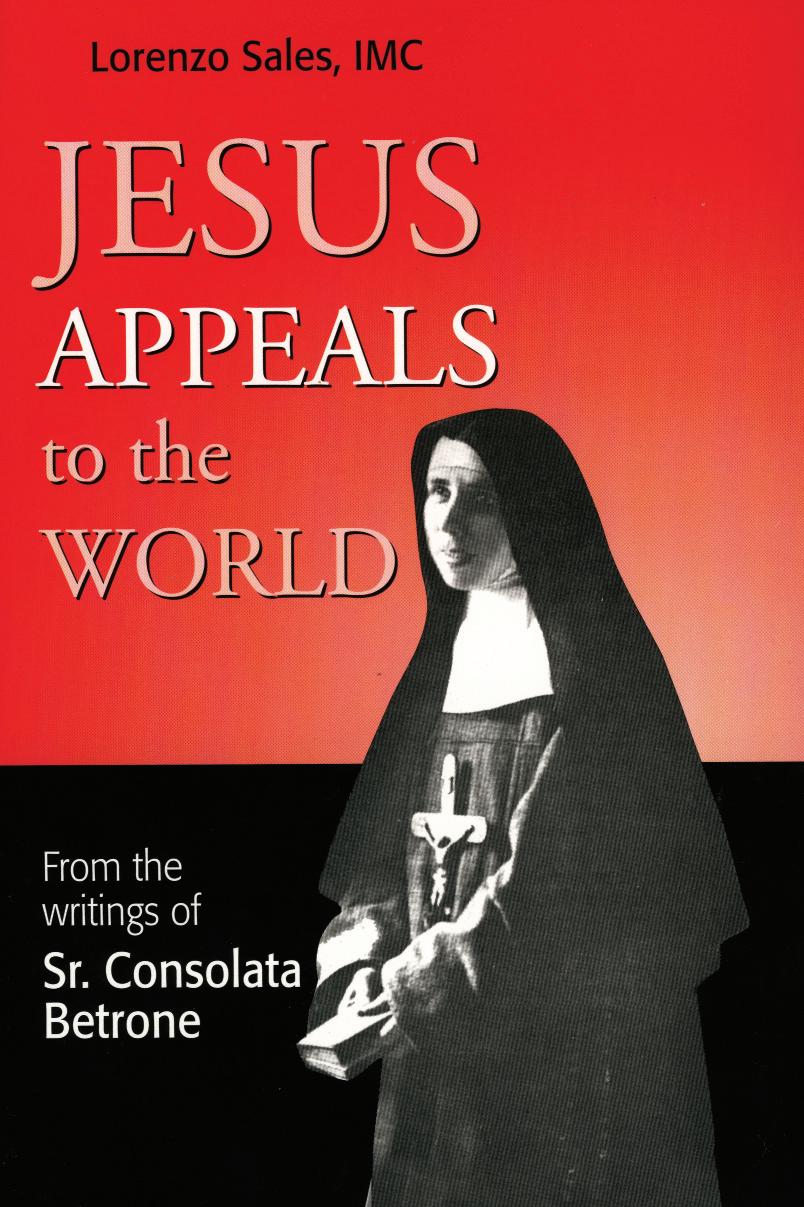

One hundred Wisdom Stories from aroud the world
Margaret Silf
RRP $27
The world abounds in wisdom stories. Some of them wager explanations for who we are and how we came to be who we are. Others offer guidance on how to live, how to relate to each other and how to cope with life. Almost all of them can be engaged with at different fields - from the simple delight of a child to the probing of the adult mind and heart in the deeper mysteries of life. The collection brings together wisdom stories from around the world from many different cultures.
From the Writings of Sr. Consolata Betrone
RRP $35
It is the prerogative of the Church to pass a definite judgement on Jesus Appeals to the World which is based on the writings of the Capuchin nun, Sister Consolata Betrone. It would be presumptuous for any person, even a priest, to judge this book. Here we are concerned with something that seems too beautiful, too luminous, too tied up with the spirit, to have originated here on earth.


The Rosary’s History, Mysteries, and Prayers
Patricia Ann Kasten
RRP $20
If you thought Archbishop Fulton Sheen and Lady Godiva had nothing in common, think again.
Whether you are a Rosary rookie or daily devotee, Linking Your Beads: The Rosary’s History, Mysteries, and Prayers will give you a whole new perspective on the power of prayer with the Rosary. As you learn the depth of faith behind this simple string of beads, prayers, and mediations, you’ll find yourself equally enlightened and encouraged by journalist, author, and storyteller Patricia Kasten. Unlike any Rosary book you’ve ever read, Kasten uses her storytelling skills to keep you engaged, amazed, and turning pages as you learn.
